Thiosemicarbazone-Based Compounds: Cancer Cell Inhibitors with Antioxidant Properties
Abstract
1. Introduction
2. Anticancer and Antioxidant Properties of the Synthetic Compounds and the Influence of Structure on Their Activity
2.1. Antiproliferative and Antioxidant Activities in Drug Development
| Compound | ABTS IC50 (µM) | SI | BxPC-3 IC50 (µM) | SI | RD IC50 (µM) | SI | HeLa IC50 (µM) | MDCK IC50 (µM) | Reference |
|---|---|---|---|---|---|---|---|---|---|
| DOXO | 12.0 | 1.8 | 6.0 | 0.7 | 16.2 | 1.8 | 6.2 | 10.8 | [47,48] |
| CDDP | 43.0 | 0.1 | 11.2 | 0.3 | 4.6 | 0.05 | 30.9 | 1.5 | [47,48] |
| Trolox | 33.3 | - | - | - | - | - | - | - | [47,48] |
2.2. Antiproliferative and Antioxidant Activities of Thiosemicarbazones
| Formula | ABTS IC50 (µM) | BxPC-3 IC50 (µM) | RD IC50 (µM) | HeLa IC50 (µM) | MDCK IC50 (µM) | Reference | |
|---|---|---|---|---|---|---|---|
| L1 | 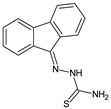 | 18.4 | ≥100 | ≥100 | ≥100 | ≥100 | [47,48] |
| L2 |  | 21.0 | ≥100 | ≥100 | ≥100 | ≥100 | [47,48] |
| L3 |  | 5.0 ± 0.2 | 0.60 | 47.7 | 10.3 | 35.8 | [47,48] |
| L4 |  | 6.7 | ≥100 | ≥100 | ≥100 | ≥100 | [47,48] |
| L5 |  | 14.2 | ≥100 | 1.1 | ≥100 | ≥100 | [46,47,48,83] |
| L6 |  | 11.6 | 0.8 | 100.4 | 4.5 | ≥100 | [46,47,48,83] |
| L7 |  | 18.7 | ≥100 | 40.2 | ≥100 | 7.9 | [46,47,48,83] |
| L8 |  | 22.1 | ≥100 | ≥100 | ≥100 | ≥100 | [46,47,48,83] |
| L9 |  | 17.5 | ≥100 | ≥100 | ≥100 | ≥100 | [46,47,48,83] |
| L10 |  | ≥100 | ≥100 | ≥100 | ≥100 | ≥100 | [46,47,48] |
| L12 |  | 13.8 | ≥100 | ≥100 | ≥100 | ≥100 | [46,47,48,83] |
| L13 |  | 92.8 | ≥100 | ≥100 | 12 | ≥100 | [46,81,83] |
| L14 |  | 8.5 | ≥100 | ≥100 | ≥100 | ≥100 | [46,47,48,81,83] |
| L15 | 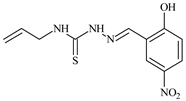 | 8.0 | 36.5 | ≥100 | ≥100 | ≥100 | [46,47,48,70,74,83] |
| L16 |  | 11.9 | ≥100 | ≥100 | ≥100 | ≥100 | [46,47,48,70,74,81] |
| L17 |  | 5.7 | ≥100 | ≥100 | ≥100 | ≥100 | [46,47,48,70,74,83] |
| L18 |  | 20.0 | ≥100 | ≥100 | ≥100 | ≥100 | [46,47,48,70,81,83] |
| L19 |  | 5.5 | ≥100 | ≥100 | ≥100 | ≥100 | [46,47,48,70,81,83] |
| L20 |  | 13.6 | ≥100 | ≥100 | ≥100 | ≥100 | [46,47,48,74,81] |
| L21 |  | 14.9 | ≥100 | 1.1 | 8.3 | ≥100 | [47,48,49] |
| L22 |  | 11.2 | ≥100 | ≥100 | ≥100 | ≥100 | [47,48,49] |
| L23 |  | 10.7 | ≥100 | ≥100 | ≥100 | ≥100 | [47,48,49] |
| L24 |  | 9.3 | ≥100 | ≥100 | ≥100 | ≥100 | [47,48,49] |
| L25 |  | 13.0 | ≥100 | ≥100 | ≥100 | ≥100 | [47,48,49] |
| L26 |  | 15.2 | ≥100 | ≥100 | ≥100 | ≥100 | [47,48,49] |
| L27 |  | 12.3 | ≥100 | ≥100 | ≥100 | ≥100 | [47,48,49] |
| L28 |  | 5.1 | ≥100 | ≥100 | ≥100 | ≥100 | [47,48,49] |
| L29 |  | 10.0 | ≥100 | ≥100 | ≥100 | ≥100 | [47,48,49] |
| L30 |  | 10.0 | ≥100 | ≥100 | ≥100 | ≥100 | [47,48,72] |
| L31 |  | 9.3 | ≥100 | ≥100 | ≥100 | ≥100 | [47,48,72] |
| L32 |  | 17.8 | ≥100 | ≥100 | ≥100 | ≥100 | [47,48,72] |
| L33 |  | 8.6 | ≥100 | ≥100 | ≥100 | ≥100 | [47,48,72] |
| L34 |  | 9.3 | ≥100 | ≥100 | ≥100 | ≥100 | [47,48,72] |
| L35 |  | 8.7 ± 0.1 | ≥100 | ≥100 | ≥100 | ≥100 | [47,48,72] |
| L36 |  | 15.6 | ≥100 | ≥100 | ≥100 | ≥100 | [47,48,72] |
| L37 |  | 7.8 | ≥100 | ≥100 | ≥100 | ≥100 | [47,48,72] |
| L38 |  | 9.7 | ≥100 | ≥100 | ≥100 | ≥100 | [47,48] |
| L39 |  | 10.1 | ≥100 | ≥100 | ≥100 | ≥100 | [47,48] |
| L40 |  | 7.2 | ≥100 | ≥100 | ≥100 | ≥100 | [47,48] |
| L41 |  | 9.1 | ≥100 | ≥100 | ≥100 | ≥100 | [47,48] |
| L42 |  | 10.2 | ≥100 | ≥100 | ≥100 | ≥100 | [47,48] |
| L43 |  | 10.0 | ≥100 | ≥100 | ≥100 | ≥100 | [47,48] |
| L44 |  | 11.2 | ≥100 | ≥100 | ≥100 | ≥100 | [47,48] |
| L45 |  | 9.4 | ≥100 | ≥100 | ≥100 | ≥100 | [47,48] |
| L46 |  | 17.7 | ≥100 | ≥100 | ≥100 | ≥100 | [47,48] |
| L47 |  | 9.8 | ≥100 | ≥100 | ≥100 | ≥100 | [47,48] |
| L48 |  | 19.9 | ≥100 | ≥100 | ≥100 | ≥100 | [47,48] |
| L49 |  | 12.8 | ≥100 | ≥100 | ≥100 | ≥100 | [47,48] |
| L50 |  | 13.1 | ≥100 | ≥100 | ≥100 | ≥100 | [47,48] |
| L51 |  | 10.3 | ≥100 | ≥100 | ≥100 | ≥100 | [47,48] |
| L52 |  | 15.8 | ≥100 | ≥100 | ≥100 | ≥100 | [47,48] |
| L53 |  | 8.6 | ≥100 | ≥100 | ≥100 | ≥100 | [47,48] |
| L54 |  | 10.6 | ≥100 | ≥100 | 7.5 | ≥100 | [47,48] |
| L55 |  | 12.3 | ≥100 | ≥100 | ≥100 | ≥100 | [47,48] |
| L56 |  | 22.1 | ≥100 | ≥100 | ≥100 | ≥100 | [47,48] |
| L57 |  | 7.2 | 6.6 | ≥100 | 21.5 | ≥100 | [47,48] |
| L58 |  | 18.2 | ≥100 | ≥100 | ≥100 | ≥100 | [47,48] |
| L59 |  | 8.9 | ≥100 | ≥100 | ≥100 | ≥100 | [47,48] |
| L60 |  | 11.9 | ≥100 | ≥100 | ≥100 | ≥100 | [47,48] |
| L61 |  | 11.8 | ≥100 | ≥100 | ≥100 | ≥100 | [47,48] |
| L62 |  | 6.3 | 0.2 | 23.4 | ≥100 | 18.2 | [47,48,49] |
| L63 |  | - | ≥100 | 62.6 | 52.2 | 8.5 | [47,48,49] |
| L64 |  | - | ≥100 | ≥100 | ≥100 | ≥100 | [47,48,49] |
| L66 |  | - | ≥100 | ≥100 | 10.7 | ≥100 | [47,48,49] |
| L67 | 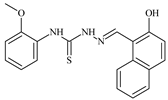 | - | ≥100 | ≥100 | ≥100 | ≥100 | [47,48,49] |
| L69 | 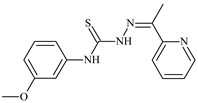 | - | ≤0.1 | 11.6 | 5.8 | 14.9 | [47,48,49] |
| L70 | 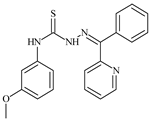 | - | ≥100 | ≥100 | ≥100 | ≥100 | [47,48,49] |
| L71 |  | - | ≥100 | ≥100 | ≥100 | ≥100 | [47,48,49] |
| L72 |  | - | ≥100 | ≥100 | ≥100 | ≥100 | [47,48,49] |
| L73 | 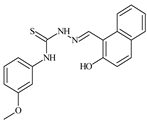 | - | ≥100 | ≥100 | ≥100 | ≥100 | [47,48,49] |
| L74 |  | - | 0.9 | ≥100 | ≥100 | 48.7 | [47,48,49] |
| L75 |  | - | ≤0.1 | 11.2 | 12.3 | 4.4 | [47,48,49] |
| L76 |  | - | ≥100 | ≥100 | ≥100 | ≥100 | [47,48,49] |
| L77 |  | 15.1 | ≥100 | ≥100 | ≥100 | ≥100 | [47,48,49] |
| L78 |  | - | ≥100 | ≥100 | ≥100 | ≥100 | [47,48,49] |
| L79 |  | - | ≥100 | ≥100 | ≥100 | ≥100 | [47,48,49] |
| L80 |  | 14.3 | ≥100 | ≥100 | ≥100 | ≥100 | [47,48,84] |
| L81 |  | 16.7 | ≥100 | ≥100 | ≥100 | ≥100 | [47,48,84] |
| L82 |  | 13.4 | ≥100 | ≥100 | ≥100 | ≥100 | [47,48,84] |
| L83 |  | 8.5 | 75.6 | 11.5 | 33.6 | 17.9 | [47,48,84] |
| L84 |  | 13.1 | ≥100 | ≥100 | ≥100 | ≥100 | [47,48,84] |
| L85 |  | 14.6 | ≥100 | ≥100 | ≥100 | ≥100 | [47,48,84] |
| L86 |  | 10.6 | ≥100 | ≥100 | ≥100 | ≥100 | [47,48,84] |
| L87 | 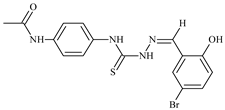 | 14.9 | ≥100 | ≥100 | ≥100 | ≥100 | [47,48,84] |
| L88 |  | 17.4 | ≥100 | ≥100 | ≥100 | ≥100 | [47,48,84] |
| L89 |  | 15.8 | ≥100 | ≥100 | ≥100 | ≥100 | [47,48,84] |
| L90 | 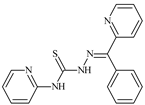 | 11.3 | ≥100 | 10.6 | ≥100 | 99.0 | [47,48,84] |
| L91 |  | 11.0 | 70.1 | ≥100 | 78.8 | ≥100 | [47,48,84] |
| L92 | 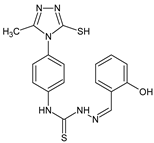 | 15.1 | 30.2 | ≥100 | 68.5 | ≥100 | [47,48,84] |
| L93 |  | 7.0 | ≥100 | ≥100 | ≥100 | ≥100 | [47,48,84] |
2.3. Antiproliferative and Antioxidant Activities of Isothiosemicarbazones
2.4. Antiproliferative and Antioxidant Activities of the 3d Metal Coordination Compounds of Thiosemicarbazones and Isothiosemicarbazones
3. Comparative Characterization of Antiproliferative Activity and Anticancer Selectivity of Thiosemicarbazones and Their 3d Metal Coordination Compounds
3.1. Antiproliferative Activity and Anticancer Selectivity of Allyl Thiosemicarbazone Pyridine Derivatives and Their 3d Metal Coordination Compounds
3.2. Antiproliferative Activity and Anticancer Selectivity of Aromatic Alil Thiosemicarbazones and Their 3d Metal Coordination Compounds
4. Action Mechanisms of the Antiproliferative and Antioxidant Activities of Some Thiosemicarbazones and Their 3d Metal Coordination Compounds
5. Conclusions
6. Future Research Directions
7. Patents
- MD 4620 B1. BOPI nr. 2/2019. GULEA Aurelian, MD; ISTRATI Dorin, MD; ŢAPCOV Victor, MD; GARBUZ Olga, MD; GUDUMAC Valentin, MD; GROPPA Stanislav, MD. Use of di(µ-S)-bis{(4-aminobenzenesulfamide)-chloro-{N-[phenyl-2-(pyridine-2-ylmethylidene)hydrazine-1-carbothioamido(1-)]}}copper as a cancer cells proliferation inhibitor.
- MD 4349 B1. BOPI nr. 5/2015. GULEA Aurelian, MD; LIPKOWSKI Andrzej, PL; GARBUZ Olga, MD; MATALINSKA Joanna, PL; ŢAPCOV Victor, MD. N-(3-methoxyphenyl)-2-(pyridine-2-ylmethylene)-hydrazinecarbothioamide compound—inhibitor of human melanoma MeW-164 cell proliferation.
- MD 4778 B1. BOPI nr. 12/2021. GULEA Aurelian, MD; GRAUR Vasilii, MD; ŢAPCOV Victor, MD; GARBUZ Olga, MD; ANDRONACHE Lilia, MD; CEBAN Emil, MD; GUDUMAC Valentin, MD. Dichloro{methyl-N-(prop-2-en-1-yl)-2-[1-(pyridin-2-yl)ethylidene]hydrazinecarbimidothioate-N,N,N}copper compound, inhibiting the proliferation of human rhabdomyosarcoma cells.
- MD 4764 B1. BOPI nr. 8/2021. GULEA Aurelian, MD; GRAUR Vasilii, MD; USATAIA Irina, MD; GARBUZ Olga, MD; ŢAPCOV Victor, MD. Dibromo{methyl-N-(prop-2-en-1-yl)-2-[1-(pyridin-2-yl)ethylidene] hydrazinecarbimidothioate-N,N,S}copper compound, inhibiting the proliferation of human rhabdomyosarcoma cells.
- MD 4407, 3 2016. A. Gulea, V. Graur and V. Țapcov, “Inhibitor al celulelor HL-60 ale leucemiei umane mieloide în baza hidratului clorurii de bis[N-(prop-2-en-1-il)-2-(piridin-2-ilmetiliden)-hidrazincarbotioamid]-nichel(II)”.
- MD 4698, BOPI 05/2020. GULEA Aurelian, MD; GUDUMAC Valentin, MD; ISTRATI Dorin, MD; USATAIA Irina, MD; GRAUR Vasilii, MD; ŢAPCOV Victor, MD; ŞVEŢ Inna, MD; PANTEA Valeriana, MD; Nitrat de catenă-(µ-nitrato-O,O“-O”)-{metil-N-(prop-2-en-1-il)-2-[1-(piridin-2-il)etiliden]hidrazincarbimidotioat}cupru(II) în calitate de inhibitor al radicalilor superoxizi.
- MD 4755, BOPI 03/2021. GULEA Aurelian, MD; GUDUMAC Valentin, MD; ŢAPCOV Victor, MD; PANTEA Valeriana, MD; GRAUR Vasilii, MD; ANDRONACHE Lilia, MD; ŞVEŢ Inna, MD; BOTNARU Maria, MD; Compuşii coordinativi ai cuprului cu 4-aliltiosemicarbazonele 3- (fenil)-1-(piridin-2-il)prop-2-en-1-onelor substituite în calitate de inhibitori ai radicalilor superoxizi.
- MD 4899, BOPI 08/2024, GULEA Aurelian, MD; ŢAPCOV Victor, MD; ISTRATI Dorin, MD; POIRIER Donald, CA; Utilizarea di(m-S)-bis{cloro-[N-(2,4-dimetilfenil)-N’-(piridin-2- ilmetiliden)carbamohidrazonotioat]cupru} tetrahidrat în calitate de inhibitor al proliferării celulelor HepG2 ale cancerului la ficat.
- MD 4749, BOPI 03/2021. GULEA Aurelian, MD; GUDUMAC Valentin, MD; ISTRATI Dorin, MD; GRAUR Vasilii, MD; ŢAPCOV Victor, MD; PANTEA Valeriana, MD; ANDRONACHE Lilia, MD; ŞVEŢ Inna, MD; Utilizarea compuşilor coordinativi ai sărurilor de cupru(II) cu 2-(2- hidroxibenziliden)-N-(prop-2-en-1-il)-hidrazincarbotioamida în calitate de inhibitori ai radicalilor superoxizi.
- Gulea Aurelian, Md., Ţapcov Victor, Md., Cebotari Diana, Md., Guţu Tatiana, Md., Istrati Dorin, Md., Gudumac Valentin, Md. [4-(2,4-Dimethylphenyl)-2-(2-hydroxy-3- methoxybenzylidene)hydrazinecarbothioamide-S][4-(2,4-dimethylphenyl)-2-, (oxo-3-methoxybenzylidene)hydrazinecarbothioamido(2-)-O,N,S]-nickel(II) monoethanol solvate as an antioxidant. 30 June 2019, BOPI nr. 6/2019.
- Gulea Aurelian, Md., Usataia Irina, Md., Garbuz Olga, Md., Graur Vasilii, Md., Ţapcov Victor, Md., Gudumac Valentin, Md. Use of salicylidene-4-allyl-S-methylisothiosemicarbazidates of iron(III) and cobalt(III) as antioxidants. 30 November 2017, BOPI nr. 11/2017.
- Gulea Aurelian, Md., Gudumac Valentin, Md., Garbuz Olga, Md., Ţapcov Victor, Md., Pahonţu Elena-Mihaela, Ro. Use of di(μ-S)-bis{(4-aminobenzenesulphamide)-chloro-[2-picolidene-4-phenylthiosemicarbazidato-(1-)]-copper(II)} as an antioxidant. 31 March 2017, BOPI nr. 3/2017.
Author Contributions
Funding
Institutional Review Board Statement
Informed Consent Statement
Data Availability Statement
Conflicts of Interest
References
- Ismail, M.A.; Arafa, R.K.; Youssef, M.M.; El-Sayed, W.M. Anticancer, antioxidant activities, and DNA affinity of novel monocationic bithiophenes and analogues. Drug Des. Dev. Ther. 2014, 8, 1659–1672. [Google Scholar] [CrossRef] [PubMed] [PubMed Central]
- Bray, F.; Jemal, A.; Grey, N.; Ferlay, J.; Forman, D. Global cancer transitions according to the Human Development Index (2008–2030): A population-based study. Lancet Oncol. 2012, 13, 790–801. [Google Scholar] [CrossRef] [PubMed]
- Roy, P.S.; Saikia, B.J. Cancer and cure: A critical analysis. Indian J. Cancer 2016, 53, 441–442. [Google Scholar] [CrossRef] [PubMed]
- Zahra, S.B.; Khan, A.; Ahmed, N.; Rafique, M.; Fatima, L.; Khan, I.; Hussain, J.; Khalid, S.; Ogaly, H.A.; Ahmed, M.M.; et al. Versatile biological activities of thiosemicarbazones and their metal complexes. J. Mol. Struct. 2025, 1322, 140511. [Google Scholar] [CrossRef]
- Kaur, M.; Loveleen; Kumar, R. Inhibition of histone deacetylases, topoisomerases and epidermal growth factor receptor by metal-based anticancer agents: Design & synthetic strategies and their medicinal attributes. Bioorg. Chem. 2020, 105, 104396. [Google Scholar] [CrossRef]
- Aly, A.A.; Abdallah, E.M.; Ahmed, S.A.; Rabee, M.M.; Bräse, S. Transition Metal Complexes of Thiosemicarbazides, Thiocarbohydrazides, and Their Corresponding Carbazones with Cu(I), Cu(II), Co(II), Ni(II), Pd(II), and Ag(I)—A Review. Molecules 2023, 28, 1808. [Google Scholar] [CrossRef]
- Pervaiz, M.; Quratulain, R.; Ejaz, A.; Shahin, M.; Saeed, Z.; Nasir, S.; Khan, R.R.M.; Ashraf, A.; Ullah, S.; Younas, U. Thiosemicarbazides, 1,3,4 thiadiazole Schiff base derivatives of transition metal complexes as antimicrobial agents. Inorg. Chem. Commun. 2023, 160, 111856. [Google Scholar] [CrossRef]
- Trotsko, N.; Głogowska, A.; Kaproń, B.; Kozieł, K.; Augustynowicz-Kopeć, E.; Paneth, A. The new thiazolidine-2,4-dione-based hybrids with promising antimycobacterial activity: Design, synthesis, biological evaluation, and drug interaction analysis. J. Enzym. Inhib. Med. Chem. 2025, 40, 2442703. [Google Scholar] [CrossRef] [PubMed] [PubMed Central]
- Rašeta, M.; Popović, M.; Knežević, P.; Šibul, F.; Kaišarević, S.; Karaman, M. Bioactive Phenolic Compounds of Two Medicinal Mushroom Species Trametes versicolor and Stereum subtomentosum as Antioxidant and Antiproliferative Agents. Chem. Biodivers. 2020, 17, e2000683. [Google Scholar] [CrossRef]
- Huang, Y.; Nishikawa, Y.; Mori, T.; Nogami, M.; Makino, A.; Kiyono, Y.; Toyama, T.; Okazawa, H. Relationship between renal oxidative stress levels and disease severity in patients with chronic kidney disease assessed by [Cu-64]ATSM PET/MRI. Sci. Rep. 2025, 15, 7227. [Google Scholar] [CrossRef] [PubMed] [PubMed Central]
- Hajas, G.; Bacsi, A.; Aguilerra-Aguirre, L.; German, P.; Radak, Z.; Sur, S.; Hazra, T.K.; Boldogh, I. Biochemical identification of a hydroperoxide derivative of the free 8-oxo-7,8-dihydroguanine base. Free Radic. Biol. Med. 2012, 52, 749–756. [Google Scholar] [CrossRef] [PubMed]
- Altıparmak, E.A.; Yazar, S.; Bal-Demirci, T. A Flexible Asymmetric Supercapacitor with High-Performance and Long-Lifetime: Fabrication of Nanoworm-Like-Structured Electrodes Based on Polypyrrole-Thiosemicarbazone Complex. Small Methods 2025, 9, e2401140. [Google Scholar] [CrossRef] [PubMed] [PubMed Central]
- Stevnsner, T.; Thorslund, T.; de Souza-Pinto, N.C.; Bohr, V.A. Mitochondrial repair of 8-oxoguanine and changes with aging. Exp. Gerontol. 2002, 37, 1189–1196. [Google Scholar] [CrossRef]
- Song, J.; Chen, H.; Pan, R.; Jin, F.; Tang, J.; Huang, Q.; Zhou, G.; Song, X. Exploring the interaction between calf thymus DNA and 11H-Indeno[1,2-b]quinoxalin-11-one Thiosemicarbazones: Spectroscopies and in vitro antitumor activity. Int. J. Biol. Macromol. 2025, 295, 139501. [Google Scholar] [CrossRef] [PubMed]
- Re, R.; Pellegrini, N.; Proteggente, A.; Pannala, A.; Yang, M.; Rice-Evans, C. Antioxidant activity applying an improved ABTS radical cation decolorization assay. Free Radic. Biol. Med. 1999, 26, 1231–1237. [Google Scholar] [CrossRef] [PubMed]
- Danişman-Kalindemirtaş, F.; Özerkan, D.; Kariper, İ.A.; Cilasun, G.E.; Ülküseven, B.; Erdem-Kuruca, S. Albumin-based nanocarriers loaded with novel Zn(II)-thiosemicarbazone compounds chart a new path for precision breast cancer therapy. Anti-Cancer Drugs 2025, 36, 208–219. [Google Scholar] [CrossRef] [PubMed]
- Munteanu, I.G.; Apetrei, C. Analytical Methods Used in Determining Antioxidant Activity: A Review. Int. J. Mol. Sci. 2021, 22, 3380–3410. [Google Scholar] [CrossRef]
- Chatterjee, K.; Zhang, J.; Honbo, N.; Karliner, J.S. Doxorubicin cardiomyopathy. Cardiology 2010, 115, 155–162. [Google Scholar] [CrossRef] [PubMed] [PubMed Central]
- Huang, S.; Liang, X.; Shi, D.; Chen, X.; Ye, S.; Liu, X.; Yang, Y.; Zou, Y.; Hu, H.; Wu, H. [64Cu]Cu(DDC)2 NPs: A Novel PET Probe for Noninvasive Visualization of NPL4 Expression in Tumors In Vivo. Mol. Pharm. 2025, 22, 1339–1347. [Google Scholar] [CrossRef] [PubMed]
- Dasari, S.; Tchounwou, P.B. Cisplatin in cancer therapy: Molecular mechanisms of action. Eur. J. Pharmacol. 2014, 740, 364–378. [Google Scholar] [CrossRef] [PubMed] [PubMed Central]
- Ghosh, S. Cisplatin: The first metal based anticancer drug. Bioorg. Chem. 2019, 88, 102925. [Google Scholar] [CrossRef] [PubMed]
- Ibrahim, A.B.M.; Mahmoud, G.A.-E.; Cordes, D.B.; Slawin, A.M.Z. Pb (II) and Hg (II) thiosemicarbazones for inhibiting the broad-spectrum pathogen Cladosporium sphaerospermum ASU18 (MK387875) and altering its antioxidant system. Appl. Organomet. Chem. 2022, 36, e6798. [Google Scholar] [CrossRef]
- Forman, H.J.; Zhang, H. Targeting oxidative stress in disease: Promise and limitations of antioxidant therapy. Nat. Rev. Drug Discov. 2021, 20, 689–709, Erratum in Nat. Rev. Drug Discov. 2021, 20, 652. [Google Scholar] [CrossRef] [PubMed]
- Bennett, L.L.; Rojas, S.; Seefeldt, T. Role of Antioxidants in the Prevention of Cancer. J. Exp. Clin. Med. 2012, 4, 215–222. [Google Scholar] [CrossRef]
- Uniyal, S.; Kumar, N.; Joshi, B.C. An Overview on Free Radicals and Role of Antioxidants in The Management of Cancer. Orient. J. Chem. 2024, 40, 120–124. [Google Scholar] [CrossRef]
- Bai, X.G.; Zheng, Y.; Qi, J. Advances in thiosemicarbazone metal complexes as anti-lung cancer agents. Front. Pharmacol. 2022, 13, 1018951. [Google Scholar] [CrossRef] [PubMed] [PubMed Central]
- Adhikari, H.S.; Garai, A.; Manandhar, K.D.; Yadav, P.N. Pyridine-Based NNS Tridentate Chitosan Thiosemicarbazones and Their Copper(II) Complexes: Synthesis, Characterization, and Anticancer Activity. ACS Omega 2022, 7, 30978–30988. [Google Scholar] [CrossRef]
- Alcaraz, R.; Muñiz, P.; Cavia, M.; Palacios, Ó.; Samper, K.G.; Gil-García, R.; Jiménez-Pérez, A.; García-Tojal, J.; García-Girón, C. Thiosemicarbazone-metal complexes exhibiting cytotoxicity in colon cancer cell lines through oxidative stress. J. Inorg. Biochem. 2020, 206, 110993. [Google Scholar] [CrossRef] [PubMed]
- Karpagam, B.; Sankarganesh, M.; Ravi, L.; Kesavan, M.P.; Kumar, G.G.V.; Rajagopal, G.; Rajesh, J. Synthesis, spectroscopic and crystal structure of nickel(II) complex of thiosemicarbazone basedSchiff base: Antimicrobial, anticancer and molecular docking studies. Inorg. Chem. Commun. 2021, 132, 108850. [Google Scholar] [CrossRef]
- Guo, C.; Wang, L.; Li, X.; Wang, S.; Yu, X.; Xu, K.; Zhao, Y.; Luo, J.; Li, X.; Jiang, B.; et al. Discovery of Novel Bromophenol-Thiosemicarbazone Hybrids as Potent Selective Inhibitors of Poly(ADP-ribose) Polymerase-1 (PARP-1) for Use in Cancer. J. Med. Chem. 2019, 62, 3051–3067. [Google Scholar] [CrossRef] [PubMed]
- Singh, A.K.; Singh, R.K.; Pandav, K.; Bano, S.; Arshi, F.; Kumar, A.; Kumar Singh, S.; Chandra, R. New Ru(III) 2,6-Bis(2-Benzimidazolyl)Pyridine Complexes Bearing P-Sub-Benzyl Thiosemicarbazones Schiff Base: Synthesis, Characterization, DNA Binding and Anti-cancer Activity. Chem.–Asian J. 2025, 20, e202500059. [Google Scholar] [CrossRef] [PubMed]
- Zhang, J.G.; Lindup, W.E. Cisplatin nephrotoxicity: Decreases in mitochondrial protein sulphydryl concentration and calcium uptake by mitochondria from rat renal cortical slices. Biochem. Pharmacol. 1994, 47, 1127–1135. [Google Scholar] [CrossRef] [PubMed]
- Lavanya, M.; Haribabu, J.; Ramaiah, K.; Yadav, C.S.; Chitumalla, R.K.; Jang, J.; Karvembu, R.; Reddy, A.V.; Jagadeesh, M. 2′ Thiophenecarboxaldehyde derived thiosemicarbazone metal complexes of copper (II), palladium(II) and zinc(II) ions. Synthesis, spectroscopic characterization, anticancer activity and DNA binding studies. Inorganica Chim. Acta 2021, 524, 120440. [Google Scholar] [CrossRef]
- Eğlence-Bakır, S.; Şahin, M.; Zahoor, M.; Dilmen-Portakal, E.; Ülküseven, B. Synthesis and biological potentials of dioxomolybdenum(VI) complexes with ONS and ONN chelating thiosemicarbazones: DNA-binding, antioxidant and enzyme inhibition studies. Polyhedron 2020, 190, 114754. [Google Scholar] [CrossRef]
- Hosseinkhah, M.; Ghasemian, R.; Shokrollahi, F.; Mojdehi, S.R.; Noveiri, M.J.S.; Hedayati, M.; Rezaei, M.; Salehzadeh, A. Cytotoxic Potential of Nickel Oxide Nanoparticles Functionalized with Glutamic Acid and Conjugated with Thiosemicarbazide (NiO@Glu/TSC) Against Human Gastric Cancer Cells. J. Clust. Sci. 2022, 33, 2045–2053. [Google Scholar] [CrossRef]
- Spreckelmeyer, S.; Orvig, C.; Casini, A. Cellular transport mechanisms of cytotoxic metallodrugs: An overview beyond cisplatin. Molecules 2014, 19, 15584–15610. [Google Scholar] [CrossRef] [PubMed] [PubMed Central]
- Meenakshi; Bera, A.; Kumar, A.; Kumar, M.; John, R.P. An efficient coumarin-based thiosemicarbazone probe for ratiometric fluorescent sensing of Zn2+ and application in live cell imaging. Spectrochim. Acta Part A Mol. Biomol. Spectrosc. 2025, 336, 126006. [Google Scholar] [CrossRef] [PubMed]
- Pan, Q.; Kleer, C.G.; Van Golen, K.L.; Irani, J.; Bottema, K.M.; Bias, C.; De Carvalho, M.; A Mesri, E.; Robins, D.M.; Dick, R.D.; et al. Copper deficiency induced by tetrathiomolybdate suppresses tumor growth and angiogenesis. Cancer Res. 2002, 62, 4854–4859. [Google Scholar] [PubMed]
- Bonaccorso, C.; Marzo, T.; La Mendola, D. Biological Applications of Thiocarbohydrazones and Their Metal Complexes: A Perspective Review. Pharmaceuticals 2019, 13, 4. [Google Scholar] [CrossRef]
- Donmez, M.; Sekerci, M.; Adiguzel, R.; Oğuz, E.; Türkan, F.; Yildiko, U.; Colak, N. Synthesis and characterization of novel bis(thiosemicarbazone) complexes and investigation of their acetylcholinesterase and glutathione S-transferase activities with in silico and in vitro studies. Mol. Divers. 2025, 29, 1109–1127. [Google Scholar] [CrossRef] [PubMed] [PubMed Central]
- Acharya, P.T.; Bhavsar, Z.A.; Jethava, D.J.; Patel, D.B.; Patel, H.D. A review on development of bio-active thiosemicarbazide derivatives: Recent advances. J. Mol. Struct. 2021, 1226, 129268. [Google Scholar] [CrossRef]
- Prajapati, N.P.; Patel, H.D. Novel thiosemicarbazone derivatives and their metal complexes: Recent development, Synth. Synth. Commun. 2019, 49, 2767–2804. [Google Scholar] [CrossRef]
- Bejarbaneh, M.; Moradi-Shoeili, Z.; Jalali, A.; Salehzadeh, A. Synthesis of Cobalt Hydroxide Nano-flakes Functionalized with Glutamic Acid and Conjugated with Thiosemicarbazide for Anticancer Activities Against Human Breast Cancer Cells. Biol. Trace Elem. Res. 2020, 198, 98–108. [Google Scholar] [CrossRef] [PubMed]
- Anjum, R.; Palanimuthu, D.; Kalinowski, D.S.; Lewis, W.; Park, K.C.; Kovacevic, Z.; Khan, I.U.; Richardson, D.R. Synthesis, Characterization, and in Vitro Anticancer Activity of Copper and Zinc Bis(Thiosemicarbazone) Complexes. Inorg. Chem. 2019, 58, 13709–13723. [Google Scholar] [CrossRef] [PubMed]
- He, Z.; Qiao, H.; Yang, F.; Zhou, W.; Gong, Y.; Zhang, X.; Wang, H.; Zhao, B.; Ma, L.; Liu, H.-M.; et al. Novel thiosemicarbazone derivatives containing indole fragment as potent and selective anticancer agent. Eur. J. Med. Chem. 2019, 184, 111764. [Google Scholar] [CrossRef]
- Graur, V.; Gulea, A. Novel Biological Agents Based on Metal Complexes of N4-Allylthiosemicarbazones and Their Derivatives. Monograph; CEP USM: Chișinău, Moldova, 2024; ISBN 978-9975-62-716-0. [Google Scholar]
- Garbuz, O.; Gudumac, V.; Toderaș, I.; Gulea, A. Antioxidant Properties of Synthetic Compounds and Natural Products. Action Mechanisms. Monograph; CEP USM: Chișinău, Moldova, 2023; ISBN 978-9975-62-516-6. [Google Scholar]
- Garbuz, O.; Toderas, I.; Gulea, A. Biological Properties of Some Synthetic and Natural Compounds. Correlation of Anticancer and Antioxidant Activities. Monograph. = Proprietăţile Biologice ale Unor Compuşi Sintetici şi Naturali. Corelarea Activităţii Anticancer şi Antioxidante. Monografie; Tipografia Centrală: Chișinău, Moldova, 2024; 271p, ISBN 978-5-88554-387-3. [Google Scholar]
- Rusnac, R.; Garbuz, O.; Kravtsov, V.; Melnic, E.; Istrati, D.; Tsapkov, V.; Poirier, D.; Gulea, A. Novel Copper(II) Coordination Compounds Containing Pyridine Derivatives of N4-Methoxyphenyl-Thiosemicarbazones with Selective Anticancer Activity. Molecules 2024, 29, 6002. [Google Scholar] [CrossRef] [PubMed] [PubMed Central]
- Czylkowska, A.; Pitucha, M.; Raducka, A.; Fornal, E.; Kordialik-Bogacka, E.; Ścieszka, S.; Smoluch, M.; Burdan, F.; Jędrzejec, M.; Szymański, P. Thiosemicarbazone-Based Compounds: A Promising Scaffold for Developing Antibacterial, Antioxidant, and Anticancer Therapeutics. Molecules 2025, 30, 129. [Google Scholar] [CrossRef]
- Carcelli, M.; Tegoni, M.; Bartoli, J.; Marzano, C.; Pelosi, G.; Salvalaio, M.; Rogolino, D.; Gandin, V. In vitro and in vivo anticancer activity of tridentate thiosemicarbazone copper complexes: Unravelling an unexplored pharmacological target. Eur. J. Med. Chem. 2020, 194, 112266. [Google Scholar] [CrossRef]
- Maurya, R.C. Bioinorganic Chemistry_ Physiological Facets_ Some New Facets (De Gruyter Textbook); De Gruyter: Berlin, Germany, 2021. [Google Scholar]
- Wecker, L. Brody’s Human Pharmacology: Mechanism-Based Therapeutics; Elsevier: Amsterdam, The Netherlands, 2018. [Google Scholar]
- Shakya, B.; Yadav, P.N. Thiosemicarbazones as Potent Anticancer Agents and their Modes of Action. Mini-Rev. Med. Chem. 2020, 20, 638–661. [Google Scholar] [CrossRef] [PubMed]
- Chaudhary, U.; Kumar, P.; Sharma, P.; Chikara, A.; Barua, A.; Mahiya, K.; Subin, J.A.; Yadav, P.N.; Pokharel, Y.R. Synthesis of 5-hydroxyisatin thiosemicarbazones, spectroscopic investigation, protein-ligand docking, and in vitro anticancer activity. Bioorg. Chem. 2024, 153, 107872. [Google Scholar] [CrossRef] [PubMed]
- Yang, L.; Liu, H.; Xia, D.; Wang, S. Antioxidant Properties of Camphene-Based Thiosemicarbazones: Experimental and Theoretical Evaluation. Molecules 2020, 25, 1192. [Google Scholar] [CrossRef] [PubMed]
- Garbuz, O.; Graur, V.; Graur, I.; Railean, N.; Toderas, I.; Pahontu, E.; Ceban, I.; Jinga, V.; Istrati, D.; Ceban, E.; et al. Biological activity of copper (II) complex (2-((2-(prop-2-en-1-ylcarbamothioyl)hydrazinylidene)methyl)phenolato)-chloro-copper (II) monohydrate. J. Cancer Sci. Clin. Ther. 2024, 8, 287–294. [Google Scholar] [CrossRef]
- Luo, S.-Y.; Zeng, C.-M.; Xu, P.; Ning, Y.; Dong, M.-L.; Zhang, W.-H.; Yu, G. Thiazole Functionalization of Thiosemicarbazone for Cu(II) Complexation: Moving toward Highly Efficient Anticancer Drugs with Promising Oral Bioavailability. Molecules 2024, 29, 3832. [Google Scholar] [CrossRef] [PubMed]
- Beraldo, H.; Gambinob, D. The wide pharmacological versatility of semicarbazones, thiosemicarbazones and their metal complexes. Mini-Rev. Med. Chem. 2004, 4, 31–39. [Google Scholar]
- Zhang, X.-H.; Wang, B.; Tao, Y.-Y.; Ma, Q.; Wang, H.-J.; He, Z.-X.; Wu, H.-P.; Li, Y.-H.; Zhao, B.; Ma, L.-Y.; et al. Thiosemicarbazone-based lead optimization to discover high-efficiency and low-toxicity anti-gastric cancer agents. Eur. J. Med. Chem. 2020, 199, 112349. [Google Scholar] [CrossRef] [PubMed]
- Kalinowski, D.S.; Sharpe, P.C.; Bernhardt, P.V.; Richardson, D.R. Design, synthesis, and characterization of new iron chelators with anti-proliferative activity: Structure-activity relationships of novel thiohydrazone analogues. J. Med. Chem. 2007, 50, 6212–6225. [Google Scholar] [CrossRef] [PubMed]
- Ciftci, G.A.; Ozdemir, A.; Altıntop, M.; Sever, B. Design, synthesis and in vitro evaluation of new thiosemicarbazone derivatives as potential anticancer agents. J. Res. Pharm. 2018, 23, 16–24. [Google Scholar]
- Soares, M.A.; Lessa, J.A.; Mendes, I.C.; Da Silva, J.G.; dos Santos, R.G.; Salum, L.B.; Daghestani, H.; Andricopulo, A.D.; Day, B.W.; Vogt, A.; et al. N4-Phenyl-substituted 2-acetylpyridine thiosemicarbazones: Cytotoxicity against human tumor cells, structure-activity relationship studies and investigation on the mechanism of action. Bioorg. Med. Chem. 2012, 20, 3396–3409. [Google Scholar] [CrossRef] [PubMed]
- Li, W.; Li, T.; Pan, Y.; Li, S.; Xu, G.; Zhang, Z.; Liang, H.; Yang, F. Designing a mitochondria-targeted theranostic cyclometalated iridium(III) complex: Overcoming cisplatin resistance and inhibiting tumor metastasis through necroptosis and immune response. J. Med. Chem. 2024, 67, 3843–3859. [Google Scholar] [CrossRef]
- Matesanz, A.I.; Herrero, J.M.; Quiroga, A.G. Chemical and biological evaluation of thiosemicarbazone-bearing heterocyclic metal complexes. Curr. Top. Med. Chem. 2021, 21, 59–72. [Google Scholar] [CrossRef]
- Qi, J.; Deng, J.; Qian, K.; Tian, L.; Li, J.; He, K.; Huang, X.; Cheng, Z.; Zheng, Y.; Wang, Y. Novel 2-pyridinecarboxaldehyde thiosemicarbazones Ga(III) complexes with a high antiproliferative activity by promoting apoptosis and inhibiting cell cycle. Eur. J. Med. Chem. 2017, 134, 34–42. [Google Scholar] [CrossRef] [PubMed]
- Graur, V.; Usataia, I.; Bourosh, P.; Kravtsov, V.; Garbuz, O.; Hureau, C.; Gulea, A. Synthesis, characterization, and biological activity of novel 3d metal coordination compounds with 2-acetylpyridine N4-allyl-S-methylisothiosemicarbazone. Appl. Organomet. Chem. 2021, 35, e6172. [Google Scholar] [CrossRef]
- Pahontu, E.; Usataia, I.; Graur, V.; Chumakov, Y.; Petrenko, P.; Gudumac, V.; Gulea, A. 4-allyl-S-methylisothiosemicarbazone: Antimicrobial, antioxidant and in vitro antiproliferative activity. Appl. Organomet. Chem. 2018, 32, e4544. [Google Scholar] [CrossRef]
- Savir, S.; Wei, Z.J.; Liew, J.W.K.; Vythilingam, I.; Lim, Y.A.L.; Saad, H.M.; Sim, K.S.; Tan, K.W. Synthesis, cytotoxicity and antimalarial activities of thiosemicarbazones and their nickel (II) complexes. J. Mol. Struct. 2020, 1211, 128090. [Google Scholar] [CrossRef]
- Graur, I.; Graur, V.; Cadin, M.; Garbuz, O.; Bourosh, P.; Melnic, E.; Lozan-Tirsu, C.; Balan, G.; Tsapkov, V.; Fala, V.; et al. Synthesis and Characterization of Copper(II) and Nickel(II) Complexes with 3-(Morpholin-4-yl)propane-2,3-dione 4-Allylthiosemicarbazone Exploring the Antibacterial, Antifungal and Antiradical Properties. Molecules 2024, 29, 3903. [Google Scholar] [CrossRef]
- Palmeira-Mello, M.V.; Teixeira, T.; de Melo, M.R.S.; Nicolella, H.D.; Dutra, J.L.; Cominetti, M.R.; Rocha, F.V.; Tavares, D.C.; Batista, A.A. Ruthenium(II)-mercapto complexes induce cell damage via apoptosis pathway on ovarian cancer cells. J. Inorg. Biochem. 2025, 265, 112819. [Google Scholar] [CrossRef] [PubMed]
- Graur, I.; Bespalova, T.; Graur, V.; Tsapkov, V.; Garbuz, O.; Melnic, E.; Bourosh, P.; Gulea, A. A new thiosemicarbazone and its 3d metal complexes: Synthetic, structural, and antioxidant studies. J. Chem. Res. 2023, 47, 1–8. [Google Scholar] [CrossRef]
- Graur, V.; Mardari, A.; Bourosh, P.; Kravtsov, V.; Usataia, I.; Ulchina, I.; Garbuz, O.; Gulea, A. Novel Antioxidants Based on Selected 3d Metal Coordination Compounds with 2-Hydroxybenzaldehyde 4,S-Diallylisothiosemicarbazone. Acta Chim. Slov. 2023, 70, 122–130. [Google Scholar] [CrossRef]
- Khatoon, S.; Asif, R.; Kalsoom, S.; Aroosh, A.; Islam, A.; Tariq, S.S.; Ul-Haq, Z.; Naseer, M.M. Novel thiosemicarbazones of coumarin incorporated isatins: Synthesis, structural characterization and antileishmanial activity. J. Biomol. Struct. Dyn. 2025, 1–13. [Google Scholar] [CrossRef] [PubMed]
- Kotian, A.; Kamat, V.; Naik, K.; Kokare, D.G.; Kumara, K.; Neratur, K.L.; Kumbar, V.; Bhat, K.; Revankar, V.K. 8-Hydroxyquinoline derived p-halo N4-phenyl substituted thiosemicarbazones. Crystal structures, spectral characterization and in vitro cytotoxic studies of their Co (III), Ni (II) and Cu (II) complexes. Bioorg. Chem. 2021, 112, 104962. [Google Scholar]
- Qi, J.; Yao, Q.; Tian, L.; Wang, Y. Piperidylthiosemicarbazones Cu(II) complexes with a high anticancer activity by catalyzing hydrogen peroxide to degrade DNA and promote apoptosis. Eur. J. Med. Chem. 2018, 158, 853–862. [Google Scholar] [CrossRef]
- Qi, J.; Zhao, W.; Zheng, Y.; Wang, R.; Chen, Q.; Wang, F.-A.; Fan, W.; Gao, H.; Xia, X. Single-crystal structure and intracellular localization of Zn(II)-thiosemicarbazone complex targeting mitochondrial apoptosis pathways. Bioorg. Med. Chem. Lett. 2020, 30, 127340. [Google Scholar] [CrossRef] [PubMed]
- Hall, I.H.; Lackey, C.B.; Kistler, T.D.; Ives, J.S.; Beraldo, H.; Ackerman, L.J.; West, D.X. The cytotoxicity of symmetrical and unsymmetrical bis(thiosemicarbazones) and their metal complexes in murine and human tumor cells. Arch. Pharm. 2000, 333, 217–225. [Google Scholar] [CrossRef] [PubMed]
- Cebotari, D.; Calancea, S.; Garbuz, O.; Balan, G.; Marrot, J.; Shova, S.; Guérineau, V.; Touboul, D.; Tsapkov, V.; Gulea, A.; et al. Synthesis, structure and biological properties of a series of dicopper (bis-thiosemicarbazone) complexes. New J. Chem. R. Soc. Chem. 2024, 48, 12043–12053. [Google Scholar] [CrossRef]
- Hall, I.H.; Lackey, C.B.; Kistler, T.D.; Durham, R.W., Jr.; Jouad, E.M.; Khan, M.; Thanh, X.D.; Djebbar-Sid, S.; Benali-Baitich, O.; Bouet, G.M. Cytotoxicity of copper and cobalt complexes of furfural semicarbazone and thiosemicarbazone derivatives in murine and human tumor cell lines. Pharmazie 2000, 55, 937–941. [Google Scholar] [PubMed]
- Gulea, A.; Toderas, I.; Garbuz, O.; Ulchina, I.; Graur, V.; Railean, N. Biological Evaluation of a Series of Amine-Containing Mixed-Ligand Copper(II) Coordination Compounds with 2-(2-hydroxybenzylidene)-N-(prop-2-en-1-yl)hydrazinecarbothioamide. Microsc. Microanal. 2022, 28, 1696–1702. [Google Scholar] [CrossRef]
- Chumakov, Y.M.; Graur, V.O.; Ulchina, Y.I.; Smaglii, V.A.; Gulea, A.P.; Garbuz, O.S.; Tsapkov, V.I. Crystal structures of [N′-(2- oxidobenzylidene)-N-(prop-2-en-1-yl)-carbamohydrazonothioato(2-)](1,10-phenanthroline)copper and [N′-(2-oxidobenzylidene)-N-(prop-2-en-1-yl)- carbamohydrazonothioato(2-)](2,2′-bipyridine)copper hemihydrates. J. Struct. Chem. 2022, 63, 905–913. [Google Scholar] [CrossRef]
- Graur, V.; Chumakov, Y.; Garbuz, O.; Hureau, C.; Tsapkov, V.; Gulea, A. Synthesis, Structure, and Biologic Activity of Some Copper, Nickel, Cobalt, and Zinc Complexes with 2-Formylpyridine N4-Allylthiosemicarbazone. Bioinorg. Chem. Appl. 2022, 2022, 2705332. [Google Scholar] [CrossRef]
- Rusnac, R.; Garbuz, O.; Chumakov, Y.; Tsapkov, V.; Hureau, C.; Istrati, D.; Gulea, A. Synthesis, Characterization, and Biological Properties of the Copper(II) Complexes with Novel Ligand: N-[4-({2-[1-(pyridin-2-yl)ethylidene]hydrazinecarbothioyl}amino)phenyl]acetamide. Inorganics 2023, 11, 408. [Google Scholar] [CrossRef]
- Baldini, M.; Belicchi-Ferrari, M.; Bisceglie, F.; Pelosi, G.; Pinelli, S.; Tarasconi, P. Cu(II) complexes with heterocyclic substituted thiosemicarbazones: The case of 5-formyluracil. Synthesis, characterization, X-ray structures, DNA interaction studies. and biological activity. Inorg. Chem. 2003, 42, 2049–2055. [Google Scholar] [CrossRef]
- Gatto, C.C.; Chagas, M.A.S.; Lima, I.J.; Andrade, F.M.; Silva, H.D.; Abrantes, G.R.; Lacerda, E.P.S. Copper(II) complexes with pyridoxal dithiocarbazate and thiosemicarbazone ligands: Crystal structure, spectroscopic analysis and cytotoxic activity. Transit. Met. Chem. 2019, 44, 329–340. [Google Scholar] [CrossRef]
- Pósa, V.; Hajdu, B.; Tóth, G.; Dömötör, O.; Kowol, C.R.; Keppler, B.K.; Spengler, G.; Gyurcsik, B.; Enyedy, É.A. The coordination modes of (thio)semicarbazone copper(II) complexes strongly modulate the solution chemical properties and mechanism of anticancer activity. J. Inorg. Biochem. 2022, 231, 111786. [Google Scholar] [CrossRef] [PubMed]
- Ribbe, M.W. Metallocofactors That Activate Small Molecules: With Focus on Bioinorganic Chemistry; Springer: Berlin/Heidelberg, Germany, 2019. [Google Scholar]
- Kovala-Demertzi, D.; Demertzis, M.A.; Filiou, E.; Pantazaki, A.A.; Yadav, P.N.; Miller, J.R.; Zheng, Y.; Kyriakidis, D.A. Platinum(II) and palladium(II) complexes with 2-acetyl pyridine 4N-ethyl thiosemicarbazone able to overcome the cis-platin resistance. Structure, antibacterial activity and DNA strand breakage. Biometals 2003, 16, 411–418. [Google Scholar] [CrossRef]
- Jouad, E.M.; Larcher, G.; Allain, M.; Riou, A.; Bouet, G.M.; Khan, M.A.; Thanh, X.D. Synthesis, structure and biological activity of nickel(II) complexes of 5-methyl 2-furfural thiosemicarbazone. J. Inorg. Biochem. 2001, 86, 565–571. [Google Scholar] [CrossRef] [PubMed]
- Hall, I.H.; Barnes, B.J.; Rowell, J.E.; Shaffer, K.A.; Cho, S.E.; West, D.X.; Stark, A.M. Cytotoxicity of 2-aldo- and 2-ketopyridine-N(4)-substituted thiosemicarbazones and mode of action in human Tmolt4 cells. Pharmazie 2001, 56, 648–653. [Google Scholar] [PubMed]
- Kovala-Demertzi, D.; Demertzis, M.A.; Miller, J.R.; Papadopoulou, C.; Dodorou, C.; Filousis, G. Platinum(II) complexes with 2-acetyl pyridine thiosemicarbazone: Synthesis, crystal structure, spectral properties, antimicrobial and antitumour activity. J. Inorg. Biochem. 2001, 86, 555–563. [Google Scholar] [CrossRef]
- Dharmasivam, M.; Zhang, S.; Zhao, X.; Richardson, V.; Wijesinghe, T.P.; Suleymanoglu, M.; Gholam Azad, M.; Bernhardt, P.V.; Kaya, B.; Richardson, D.R. Advantages of Novel Anti-cancer Selenosemicarbazones: Preferential Reactivity of Their Fe(III), Cu(II), and Zn(II) Complexes with Key Physiological Reductants/Ligands Versus Isosteric Thiosemicarbazones. J. Med. Chem. 2025. [Google Scholar] [CrossRef] [PubMed]
- Guveli, S.; Ozdemir, N.; Ulkuseven, B.; Bal-Demirci, T. Divalent nickel complexes of thiosemicarbazone based on 5-bromosalicylaldehyde and triphenylphosphine: Experimental and theoretical characterization. Polyhedron 2016, 113, 16–24. [Google Scholar] [CrossRef]
- Azarkish, M.; Akbari, A.; Sedaghat, T.; Simpson, J. Heteroleptic complexes of Zn(II) based on 1-(5-bromo-2-hydroxybenzylidene)-4-phenylthiosemicarbazide: Synthesis, structural characterization, theoretical studies and antibacterial activity. J. Mol. Struct. 2017, 1134, 126–134. [Google Scholar] [CrossRef]
- Jiang, X.; Fielding, L.A.; Davis, H.; Carroll, W.; Lisic, E.C.; Deweese, J.E. Inhibition of topoisomerases by metal thiosemicarbazone complexes. Int. J. Mol. Sci. 2023, 24, 12010. [Google Scholar] [CrossRef]
- Kalinowski, D.S.; Quach, P.; Richardson, D.R. Thiosemicarbazones: The new wave in cancer treatment. Future Med. Chem. 2009, 1, 1143–1151. [Google Scholar] [CrossRef] [PubMed]
- Zheng, Y.; An, H.; Qi, J.; Li, J. Recent progress in thiocarbazone metal complexes for cancer therapy via mitochondrial signalling pathway. Front. Chem. 2024, 12, 1424022. [Google Scholar] [CrossRef] [PubMed] [PubMed Central]
- Hohnsen, J.; Rryci, L.; Obretenova, D.; Friedel, J.; Jouchaghani, S.; Klein, A. Functionalizing Thiosemicarbazones for Covalent Conjugation. Molecules 2024, 29, 3680. [Google Scholar] [CrossRef] [PubMed] [PubMed Central]
- Aghvami, M.; Ebrahimi, F.; Zarei, M.H.; Salimi, A.; Pourahmad, R.J.; Pourahmad, J. Matrine Induction of ROS Mediated Apoptosis in Human ALL B-lymphocytes Via Mitochondrial Targeting. Asian Pac. J. Cancer Prev. 2018, 19, 555–560. [Google Scholar] [CrossRef] [PubMed] [PubMed Central]
- Ahmad, G.; Mir, S.A.; Anand, L.K.; Pottoo, F.H.; Dhiman, N.; Malik, F.; Ali, A. Myricanol-9-acetate, a Novel Naturally Occurring Derivative of Myricanol, Induces ROS-dependent Mitochondrial-mediated Apoptosis in MCF-7 Cancer Cells. Curr. Top. Med. Chem. 2021, 21, 1418–1427. [Google Scholar] [CrossRef] [PubMed]
- Wang, Y.; Wang, Z.; Kuang, H.; Zhang, Y.; Gu, W.; Zhu, Y.; Wang, S. Synthesis and antitumor activity of 2-isocamphanyl thiosemicarbazone derivatives via ROS-enhanced mitochondrial damage. Chem. Biol. Drug Des. 2019, 94, 1281–1291. [Google Scholar] [CrossRef] [PubMed]
- Beraldo, H.; Nacif, W.F.; West, D.X. Spectral studies of semicarbazones derived from 3- and 4-formylpyridine and 3- and 4-acetylpyridine: Crystal and molecular structure of 3-formylpyridine semicarbazone. Spectrochim. Acta Part A Mol. Biomol. Spectrosc. 2001, 57, 1847–1854. [Google Scholar] [CrossRef] [PubMed]
- Cantoni, O.; Zito, E.; Guidarelli, A.; Fiorani, M.; Ghezzi, P. Mitochondrial ROS, ER Stress, and Nrf2 Crosstalk in the Regulation of Mitochondrial Apoptosis Induced by Arsenite. Antioxidants 2022, 11, 1034. [Google Scholar] [CrossRef] [PubMed] [PubMed Central]
- Melha, K.S.A. In-Vitro Antibacterial, Antifungal Activity of Some Transition Metal Complexes of Thiosemicarbazone Schiff Base (HL) Derived from N4-(7′-Chloroquinolin-4′-Ylamino) Thiosemicarbazide. J. Enzym. Inhib. Med. Chem. 2008, 23, 493–503. [Google Scholar] [CrossRef]
- Zarewa, S.A.; Binobaid, L.; Sulaiman, A.A.A.; Sobeai, H.M.A.; Alotaibi, M.; Alhoshani, A.; Isab, A.A. Synthesis, Characterization, and Anticancer Activity of Phosphanegold(i) Complexes of 3-Thiosemicarbano-butan-2-one Oxime. Biomedicines 2023, 11, 2512. [Google Scholar] [CrossRef] [PubMed] [PubMed Central]
- Degitz, C.; Reime, S.; Thews, O. Effect of Acidosis-Induced Signalling Pathways on Mitochondrial O2 Consumption of Tumour Cells. In Oxygen Transport to Tissue XLIII, Proceedings of the Oxygen Transport to Tissue XLIII, Ascona, Switzerland, 27–30 July 2021; Scholkmann, F., LaManna, J., Wolf, U., Eds.; Advances in Experimental Medicine and Biology; Springer: Cham, Switzerland, 2022; Volume 1395, pp. 231–235. [Google Scholar] [CrossRef] [PubMed]
- Peretz, E.; Ashkenazi, N.; Musa, S. Cannabidiol-Based Thiosemicarbazones: A Preliminary Study Evaluating Their Anti-Tyrosinase Properties. Molecules 2025, 30, 1291. [Google Scholar] [CrossRef] [PubMed] [PubMed Central]
- West, D.X.; Liberta, A.E.; Padhye, S.B.; Chikate, R.C.; Sonawane, P.B.; Kumbhar, A.S.; Yerande, R.G. Thiosemicarbazone Complexes of Copper(II): Structural and Biological Studies. Coord. Chem. Rev. 1993, 123, 49–71. [Google Scholar] [CrossRef]
- Gou, Y.; Wang, J.; Chen, S.; Zhang, Z.; Zhang, Y.; Zhang, W.; Yang, F. α–N–heterocyclic thiosemicarbazone Fe(III) complex: Characterization of its antitumor activity and identification of anticancer mechanism. Eur. J. Med. Chem. 2016, 123, 354–364. [Google Scholar] [CrossRef] [PubMed]
- El-Ayaan, U.; Youssef, M.M.; Al-Shihry, S. Mn(II), Co(II), Zn(II), Fe(III) and U (VI) Complexes of 2-Acetylpyridine 4N-(2-Pyridyl) Thiosemicarbazone (HAPT); Structural, Spectroscopic and Biological Studies. J. Mol. Struct. 2009, 936, 213–219. [Google Scholar] [CrossRef]
- Shyamsivappan, S.; Vivek, R.; Saravanan, A.; Arasakumar, T.; Suresh, T.; Athimoolam, S.; Mohan, P.S. A novel 8-nitro quinoline-thiosemicarbazone analogues induces G1/S and G2/M phase cell cycle arrest and apoptosis through ROS mediated mitochondrial pathway. Bioorg. Chem. 2020, 97, 103709. [Google Scholar] [CrossRef]
- Gu, S.; Yu, P.; Hu, J.; Liu, Y.; Li, Z.; Qian, Y.; Wang, Y.; Gou, Y.; Yang, F. Mitochondria-localizing N-heterocyclic thiosemicarbazone copper complexes with good cytotoxicity and high antimetastatic activity. Eur. J. Med. Chem. 2019, 164, 654–664. [Google Scholar] [CrossRef]
- Eshal, J.; Tariq, H.Z.; Li, J.; Aftab, H.; Şenol, H.; Taslimi, P.; Sadeghian, N.; Alharthy, R.D.; Akram, M.S.; Talib, R.; et al. Synthesis, biological evaluation, and in silico studies of phenyl naphthalene-2-sulfonate derived thiosemicarbazones as potential carbonic anhydrase inhibitors. Bioorg. Chem. 2025, 155, 108118. [Google Scholar] [CrossRef] [PubMed]
- Zeglis, B.M.; Divilov, V.; Lewis, J.S. Role of metalation in the topoisomerase IIα inhibition and antiproliferation activity of a series of α-heterocyclic-N4-substituted thiosemicarbazones and their Cu(II) complexes. J. Med. Chem. 2011, 54, 2391–2398. [Google Scholar] [CrossRef]
- Hamad, H.T. The anti-cancer effectiveness of some heterocyclic compounds containing sulfur atom. Results Chem. 2025, 15, 102182. [Google Scholar] [CrossRef]
- Lu, T.; Chen, F. Multiwfn: A multifunctional wavefunction analyzer. J. Comput. Chem. 2012, 33, 580–592. [Google Scholar] [CrossRef] [PubMed]
- Haribabu, J.; Srividya, S.; Mahendiran, D.; Gayathri, D.; Venkatramu, V.; Bhuvanesh, N.; Karvembu, R. Synthesis of palladium(II) complexes via michael addition: Antiproliferative effects through ROS-mediated mitochondrial apoptosis and docking with SARS-CoV-2. Inorg. Chem. 2020, 59, 17109–17122. [Google Scholar] [CrossRef] [PubMed]
- Fuior, A.; Hijazi, A.; Garbuz, O.; Bulimaga, V.; Zosim, L.; Cebotari, D.; Haouas, M.; Toderaş, I.; Gulea, A.; Floquet, S. Screening of biological properties of MoV2O2S2- and MoV2O4-based coordination complexes: Investigation of antibacterial, antifungal, antioxidative and antitumoral activities versus growing of Spirulina platensis biomass. J. Inorg. Biochem. 2022, 226, 111627. [Google Scholar] [CrossRef] [PubMed]

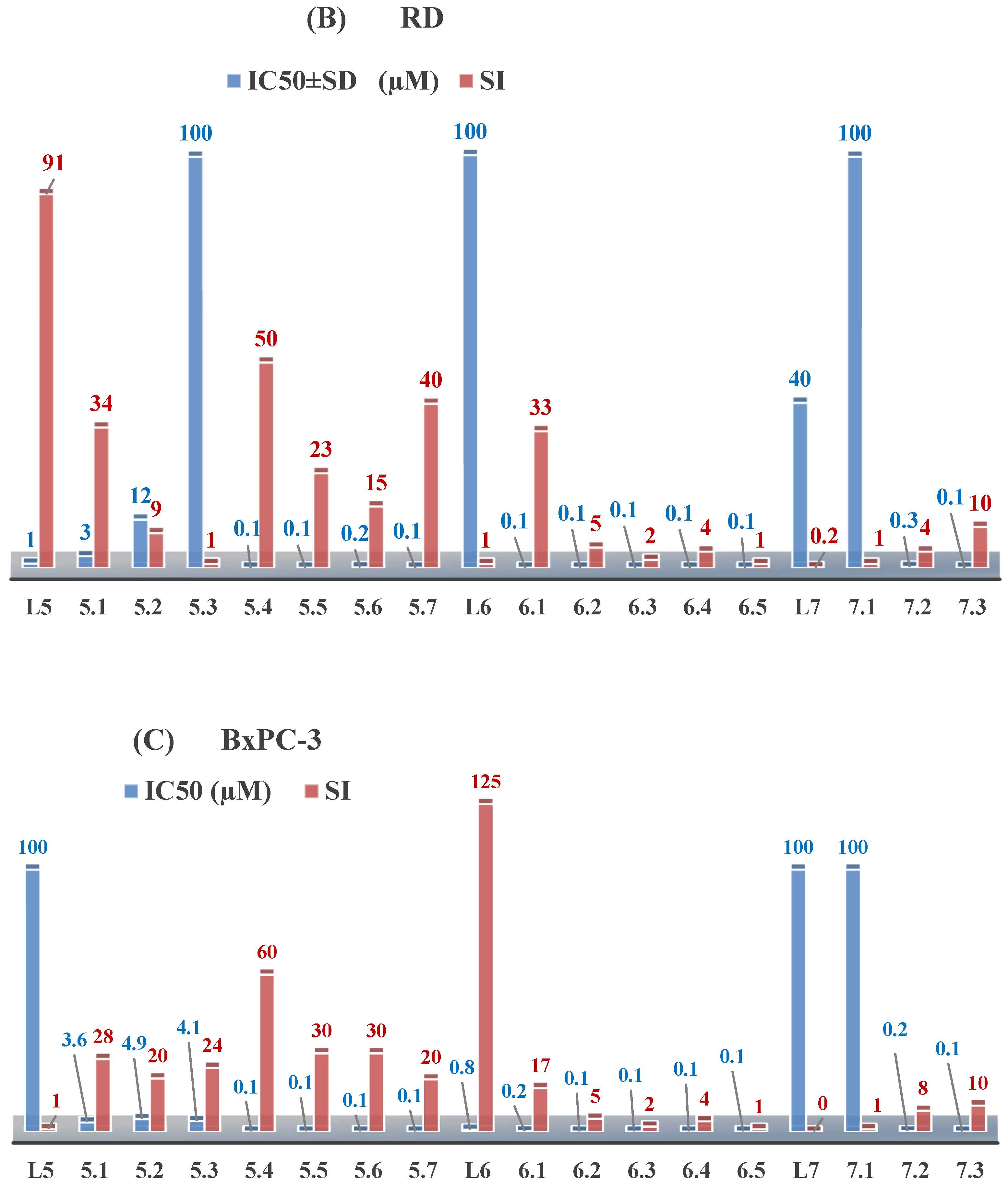
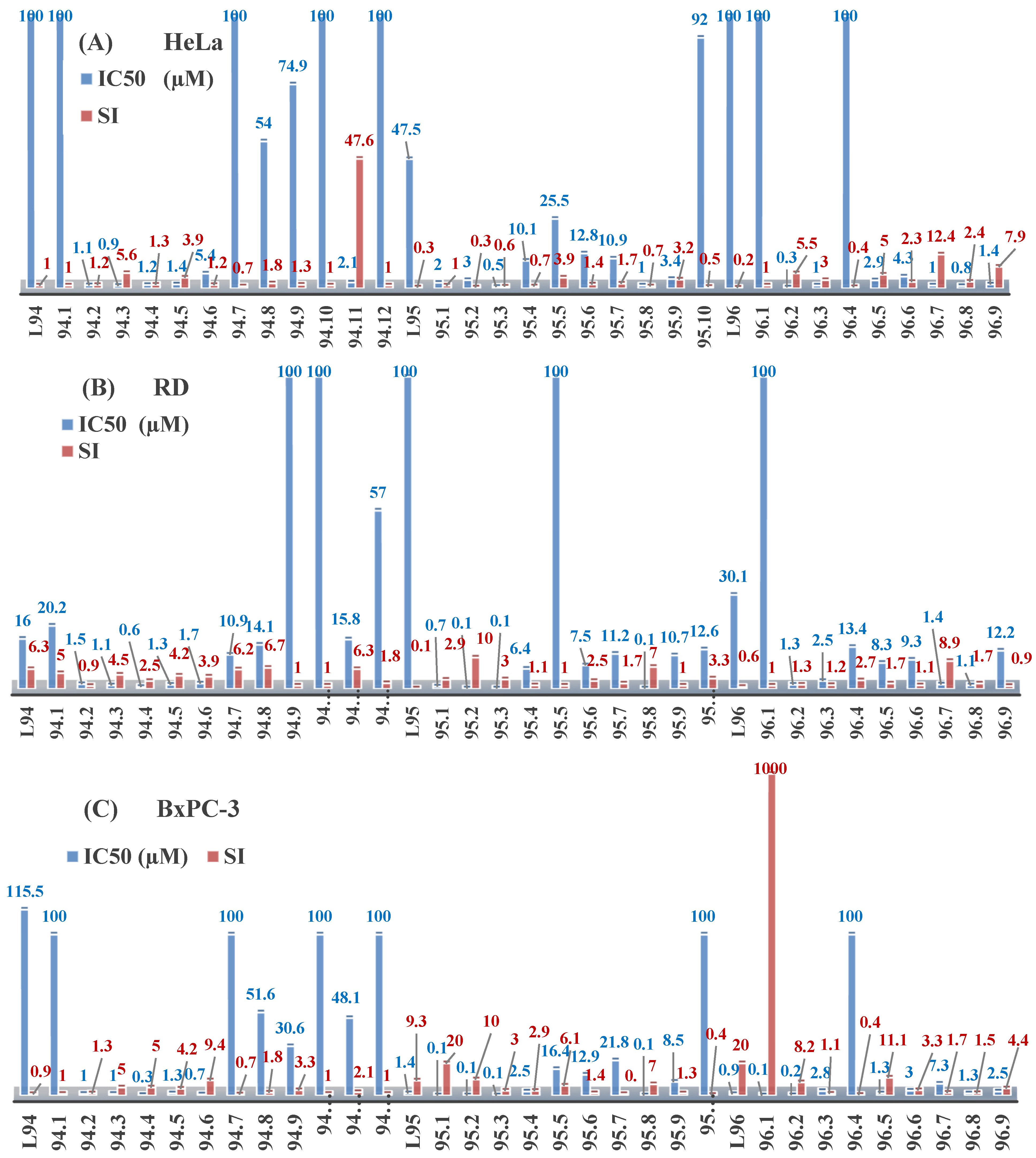

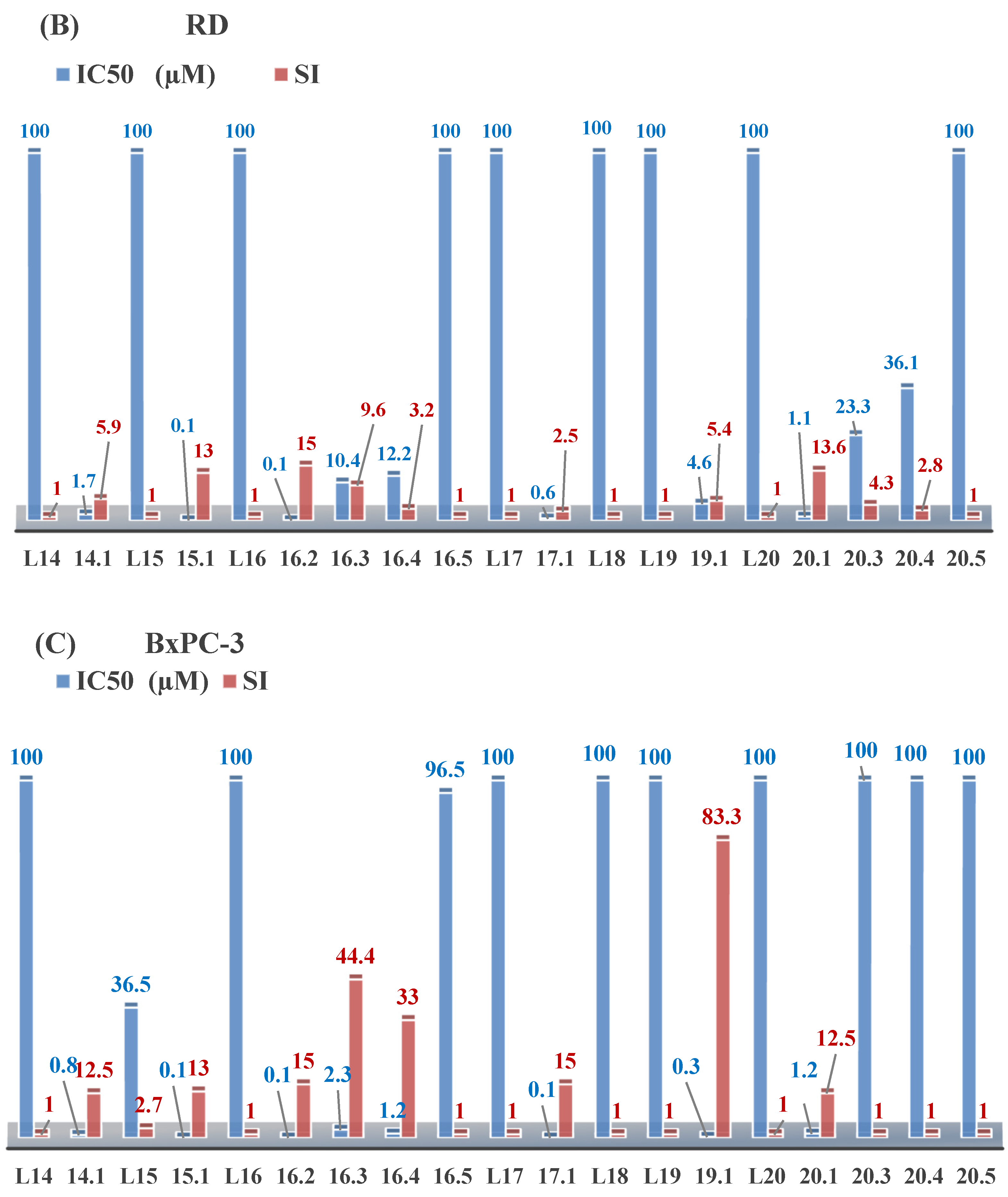
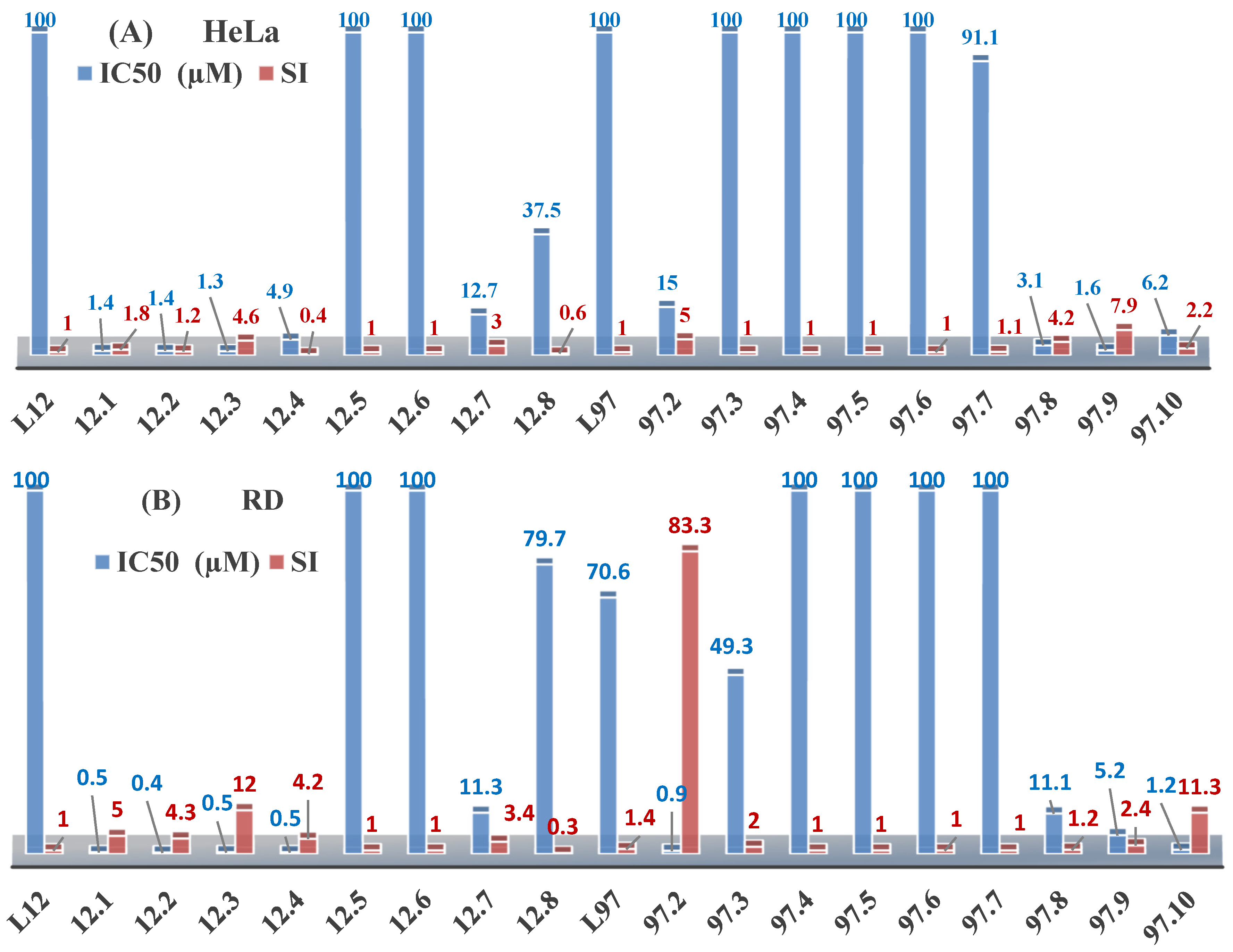

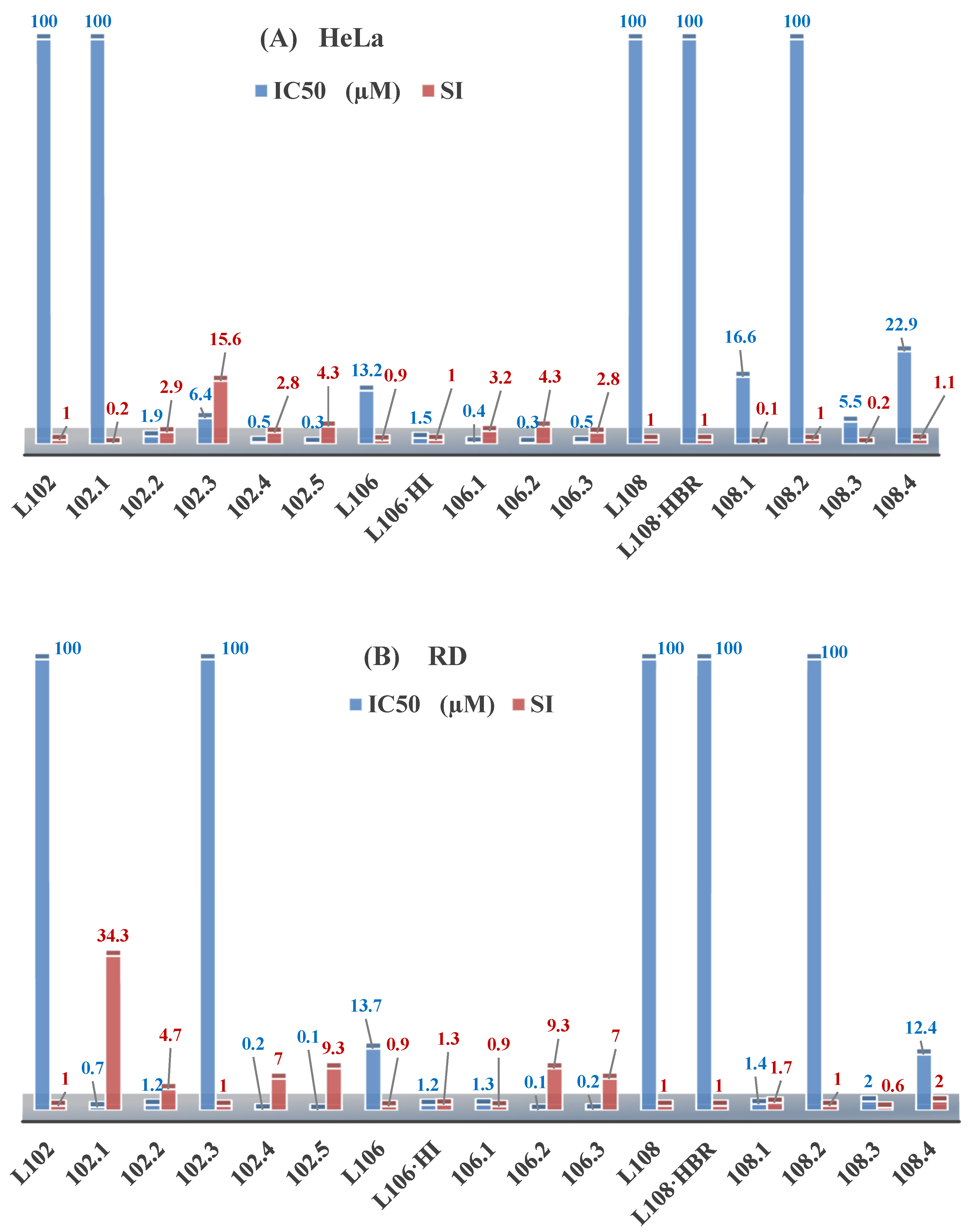

| Formula | ABTS IC50 (µM) | BxPC-3 IC50 (µM) | RD IC50 (µM) | HeLa IC50 (µM) | MDCK IC50 (µM) | Reference | |
|---|---|---|---|---|---|---|---|
| L94 |  | ≥100 | 115.5 | 16.0 | ≥100 | ≥100 | [46,47,48,67,73] |
| L94·HI | ≥100 | ≥100 | 20.2 | ≥100 | ≥100 | [46,47,48,67] | |
| L95 |  | ≥100 | 1.4 | ≥100 | 47.5 | 13.0 | [46,47,48,73] |
| L96 |  | - | 0.9 | 30.1 | ≥100 | 18.0 | [46,47,48,67] |
| L97 |  | - | ≥100 | 70.6 | ≥100 | ≥100 | [46,47,48,67,73] |
| L97·HI | ≥100 | ≥100 | ≥100 | ≥100 | [46,47,48] | ||
| L98 |  | 8.8 | 35.9 | 44.7 | 5.2 | ≥100 | [46,47,48,67,73,82] |
| L98·HI | 7.7 | 72.7 | 126.3 | 4.0 | ≥100 | ||
| L99·HI |  | 8.7 | ≥100 | ≥100 | ≥100 | ≥100 | [46,57,67,82] |
| L100 |  | - | ≥100 | 99.8 | 90 | 53 | [46,67,82] |
| L101 |  | 51.2 | 14.2 | ≥100 | 81.4 | ≥100 | [46,67,82] |
| L102 |  | ≥100 | 15.5 | ≥100 | ≥100 | ≥100 | [46,67,73,82] |
| L102·HI | 41.2 | 0.01 | 0.7 | ≥100 | 24 | [46,57] | |
| L103·HI | 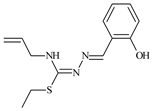 | 13.7 | 88.0 | ≥100 | ≥100 | ≥100 | [46,67,82] |
| L104 |  | 6.9 | ≥100 | ≥100 | ≥100 | ≥100 | [46,57,67,73,82] |
| L104·HI | 8.6 | 0.4 | 1.0 | 1.4 | 1.0 | [46] | |
| L105·HI |  | 6.2 | ≥100 | ≥100 | ≥100 | ≥100 | [46,57,67,82] |
| L106 |  | ≥100 | 13.5 | 13.71 | 13.2 | 11.9 | |
| L106·HI | 49.9 | 0.47 | 1.18 | 1.45 | 1.5 | [46] | |
| L107 |  | 34.0 | 57.6 | 10.8 | 27.5 | 0.1 | [47,48,67] |
| L108 |  | ≥100 | ≥100 | ≥100 | ≥100 | ≥100 | [46,57,67,74] |
| L108·HBr | 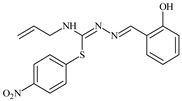 | 31.0 | 48.5 | ≥100 | ≥100 | ≥100 | [46,67,74] |
| L109 | 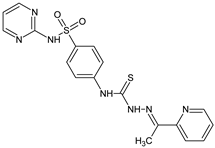 | 29.0 | ≥100 | ≥100 | ≥100 | ≥100 | [47,48] |
| Formula | ABTS IC50 (µM) | BxPC-3 IC50 (µM) | RD IC50 (µM) | HeLa IC50 (µM) | MDCK IC50 (µM) | Reference | |
|---|---|---|---|---|---|---|---|
| 5.1 | Co(L2-H)2(CH3COO) | ≥100 | ≥100 | ≥100 | ≥100 | ≥100 | [47,48] |
| 5.2 | Ni(L5)2Cl2 | - | 3.6 | 2.92 | ≥100 | ≥100 | [46,47,48,83] |
| 5.3 | Ni(L5-H)2 | - | 4.9 | 11.81 | ≥100 | ≥100 | |
| 5.4 | Co(L5-H)2Cl | - | 4.1 | ≥100 | 14.2 | ≥100 | |
| 5.5 | Cu(L5)(NO3)2 | - | ≤0.1 | 0.12 | 0.6 | 6 | |
| 5.6 | Cu(L5-H)Cl | - | ≤0.1 | 0.13 | 0.6 | 3 | |
| 5.7 | Cu(L5-H)Br | - | ≤0.1 | 0.2 | 0.3 | 3 | |
| 5.8 | Cu(L5-H)CH3COO | - | ≤0.1 | 0.05 | 0.2 | 2 | |
| 5.9 | Cu(Im)(L5-H)NO3 | - | 0.1 | 0.2 | 4 | 3 | |
| 5.10 | Cu(3.5-Lut)(L5-H)NO3 | - | ≤0.1 | 0.1 | 0.5 | 0.3 | |
| 6.1 | Cu(L6)(NO3)2 | 29.8 | 0.18 | 0.09 | 2.2 | 3 | [46,47,48,83] |
| 6.2 | Cu(L6-H)(CH3COO) | 26.8 | ≤0.1 | 0.1 | 1.3 | 0.5 | |
| 6.3 | Cu(L6-H)Cl | ≥100 | ≤0.1 | ≤0.1 | 0.5 | 0.2 | |
| 6.4 | Cu(L6-H)Br | ≥100 | ≤0.1 | ≤0.1 | 0.4 | 0.4 | |
| 6.5 | (Cu(L6-H))2SO4 | 38.7 | ≤0.1 | ≤0.1 | 0.4 | 0.1 | |
| 6.6 | Cu(4-Pic)(L6-H)(NO3) | - | ≤0.01 | 0.5 | 1.5 | 1.6 | |
| 6.7 | Cu(2.2′-Bpy)(L6-H)(NO3) | - | ≤0.01 | 1.29 | 1.9 | 1.4 | |
| 6.8 | Cu(1.10-Phen)(L6-H)(NO3) | - | 0.14 | 1.1 | 0.7 | 3.2 | |
| 7.1 | Ni(L7)2(NO3)2 | - | ≥100 | ≥100 | ≥100 | ≥100 | [46,47,48,83] |
| 7.2 | Cu(L7-H)(NO3) | ≥100 | 0.15 | 0.3 | 1.4 | 1.2 | |
| 7.3 | Cu(L7-H)Cl | 52.9 | ≤0.1 | 0.1 | 0.02 | 1 | |
| 12.1 | Cu(L12-H)Cl | 51.8 | 0.6 | 0.5 | 1.4 | 2.5 | [46,47,48,83] |
| 12.2 | Cu(L12-H)Br | 52.7 | 0.3 | 0.4 | 1.4 | 1.7 | |
| 12.3 | Cu(L12-H)(NO3) | 76.2 | ≤0.1 | 0.5 | 1.3 | 6 | |
| 12.4 | Cu(L12-2H)H2O | 44.9 | 0.1 | 0.5 | 4.9 | 2.1 | |
| 12.5 | Co(L12-H)2Cl | 21.4 | ≥100 | ≥100 | ≥100 | ≥100 | |
| 12.6 | Ni(L12)(L12-H)Cl | 3.6 | ≥100 | ≥100 | ≥100 | ≥100 | |
| 12.7 | Zn(L12-H)Cl | 9.2 | ≥100 | 11.3 | 12.7 | 38.6 | |
| 12.8 | Fe(L12-H)2(NO3) | 2.4 | ≥100 | 79.7 | 37.5 | 24.1 | |
| 12.9 | Cu(Im)(L12-H)(NO3) | 5.8 | 0.02 | 1.8 | 7 | 12 | |
| 12.10 | Cu(3.5Br2Py)(L12-H)(NO3)where 3.5Br2Py is | 7.5 | 0.05 | 1.03 | 5 | 9 | |
| 14.1 | Cu(L14-H)Cl | ≥100 | 0.8 | 1.7 | 2 | 10 | [46,47,48,81,83] |
| 15.1 | Cu(L15-H)Cl | 68.3 | ≤0.1 | 0.1 | 0.2 | 1.3 | [46,47,48,70,74,83] |
| 16.1 | Cu(L16-H)NO3·H2O | 18.7 | 10.47 | 0.36 | 92 | 84 | [46,47,48,70,74,81] |
| 16.2 | Cu(Py)(L16-H)NO3 | ≤0.1 | 0.1 | 1.48 | 1.5 | ||
| 16.3 | Cu(L16-2H)H2O | ≥100 | 2.25 | 10.4 | 1.2 | ≥100 | |
| 16.4 | Cu(L16-H)Br | ≥100 | 1.2 | 12.2 | 3.7 | 39.6 | |
| 16.5 | Co(L16-H)2NO3 | 59.4 | 96.5 | ≥100 | 28.79 | ≥100 | |
| 17.1 | Cu(L17-H)NO3 | 7.1 | 0.1 | 0.6 | 1.5 | 1.5 | [46,47,48,70,74,83] |
| 19.1 | Cu(L19-H)NO3 | 8.6 | 0.3 | 4.6 | 13 | 25 | |
| 20.1 | Cu(L20-H)Cl | 14.2 | 1.2 | 1.1 | 3.9 | 15.0 | [46,47,48,74,81] |
| 20.2 | Cu(L20-H)NO3 | 14.4 | ≥100 | 6.8 | 8 | 9 | |
| 20.3 | Co(L20-H)2NO3 | 8.5 | ≥100 | 23.3 | 65.3 | ≥100 | |
| 20.4 | Ni(L20)(L20-H)Cl | 8.5 | ≥100 | 36.1 | 90.0 | ≥100 | |
| 20.5 | Cr(L20-H)2NO3 | 0.9 | ≥100 | ≥100 | ≥100 | ≥100 | |
| 21.1 | Cu(L21-H)Cl | 4.5 | 0.5 | 0.2 | 2.1 | 4 | [47,48,49] |
| 21.2 | Cu(Str)(L21-H)Clwhere Str is | 6.2 | 1.6 | 1.3 | 0.4 | 12 | |
| 33.1 | Cu(1.10-Phen)(L33-2H) | 11.8 | 2.0 | 10.9 | 4.6 | 13.0 | [47,48,72] |
| 37.1 | Cu(L37-H)(NO3) | 19.6 | 2.6 | 19.2 | 3.5 | 60.2 | |
| 37.2 | Cu(L37-H)Br | 38.3 | 9.3 | 11.2 | 59.7 | 15.1 | |
| 37.3 | Cu(L37-H)Cl | 27.2 | 6.2 | 9.3 | 10.9 | 12.5 | |
| 37.4 | Cu2(L37-H)2SO4 | 13.2 | 16.97 | ≥100 | 76.7 | ≥100 | |
| 37.5 | Ni(L37-H)2 | 7.2 | ≥100 | ≥100 | ≥100 | ≥100 | |
| 37.6 | Co(L37-H)2(NO3) | 14.2 | ≥100 | ≥100 | ≥100 | ≥100 | |
| 44.1 | Cu(L44-H)Br | 5.7 | 6.8 | ≥100 | 61.3 | ≥100 | [47,48] |
| 44.2 | Cu(L44-H)Cl | 15.7 | 16.5 | ≥100 | ≥100 | ≥100 | |
| 44.3 | Cu(L44-H)NO3·H2O | 9.5 | 1.6 | ≥100 | 5.6 | ≥100 | |
| 44.4 | Ni(L44-H)2 | 2.9 | ≥100 | ≥100 | ≥100 | ≥100 | |
| 44.5 | Ni(L44-2H)(H2O) | 11.3 | ≥100 | ≥100 | ≥100 | ≥100 | |
| 44.6 | Co(L44-H)2Cl | 8.3 | ≥100 | ≥100 | ≥100 | ≥100 | |
| 44.7 | Co(L44-H)2(NO3) | 12.0 | ≥100 | ≥100 | ≥100 | ≥100 | |
| 44.8 | Fe(L44-H)2Cl | 5.4 | ≥100 | ≥100 | ≥100 | ≥100 | |
| 44.9 | Fe(L44-H)(NO3)2(H2O) | 18.6 | 55.6 | ≥100 | 73.2 | ≥100 | |
| 44.10 | Fe(L44-H)2(NO3) | 6.2 | ≥100 | ≥100 | ≥100 | ≥100 | |
| 44.11 | K2Mn(L44-2H)2 | 10.1 | 23.8 | ≥100 | 6.2 | ≥100 | |
| 44.12 | Cu(L44-2H)(H2O) | 6.9 | 3.0 | 9.7 | 5.2 | 6.3 | |
| 44.13 | Cu(L44-H)ClO4 | 8.1 | 24.7 | ≥100 | 24.5 | ≥100 | |
| 49.1 | Cu2(L49-H)2SO4 | ≥100 | 2.5 | 12.7 | 8.6 | 11.4 | |
| 49.2 | Ni(L49-H)Cl | 9.6 | ≥100 | ≥100 | ≥100 | ≥100 | |
| 54.1 | Cu(L54-H)NO3·H2O | 15.7 | 4.2 | ≥100 | 3.5 | ≥100 | [47,48] |
| 54.2 | Ni(L54-H)Cl | 13.2 | 32.2 | ≥100 | 12.5 | ≥100 | |
| 54.3 | Cu(L54-H)Br | 9.3 | 6.8 | 2.0 | 2.8 | 9.0 | |
| 54.4 | Cu(L54-H)ClO4·4H2O | 30.8 | 11.8 | 9.3 | 4.7 | 13.0 | |
| 54.5 | Cu(L54-H)Cl | 7.5 | 6.6 | ≥100 | 21.5 | ≥100 | |
| 54.6 | Co(L54-H)2Cl | 7.5 | ≥100 | ≥100 | ≥100 | ≥100 | |
| 54.7 | Co(L54-H)2(NO3) | 11.1 | ≥100 | ≥100 | ≥100 | ≥100 | |
| 54.8 | Ni(L54-2H)(H2O) | 15.6 | 30.1 | ≥100 | 98.7 | ≥100 | |
| 54.9 | Cu(L54-2H)(H2O) | 8.5 | 13.1 | ≥100 | 30.3 | ≥100 | |
| 57.1 | Ni(L57-2H)(H2O) | 17.6 | ≥100 | ≥100 | ≥100 | ≥100 | [47,48,49] |
| 57.2 | Ni(L57-H)2 | 12.7 | ≥100 | ≥100 | ≥100 | ≥100 | |
| 60.1 | Cu(L60-2H)(H2O) | ≥100 | 9.8 | 7.7 | 86.4 | 30.3 | |
| 60.2 | Cu(L60-H)Cl | 76.5 | 9.7 | ≥100 | 44.1 | 84.1 | |
| 60.3 | Cu(L60-H)Br | - | 4.81 | ≥100 | 28.6 | - | |
| 60.4 | Cu(L60-H)(NO3) | 91.9 | 5.9 | 6.7 | 77.8 | 12.5 | |
| 60.5 | Ni(L60-2H)(H2O) | 14.3 | ≥100 | ≥100 | ≥100 | ≥100 | |
| 63.1 | Cu(L63-H)NO3 | 19.9 | 0.10 | 1.9 | 1.08 | 2.4 | |
| 63.2 | Cu(L63-H)Cl | 22.4 | 1.2 | 16.4 | 5.9 | 14.8 | |
| 64.5 | Cu(L64-H)Cl | 82.5 | 15.4 | ≥100 | 27.6 | ≥100 | |
| 64.6 | Cu(L64-H)NO3 | 23.0 | ≤0.1 | 1.3 | 0.77 | 1.7 | |
| 64.7 | Co(L64-H)2Cl | 18.7 | 1.01 | ≥100 | 3.1 | ≥100 | |
| 64.8 | Ni(L64-H)Cl | - | 0.8 | ≥100 | 1.7 | ≥100 | |
| 65.1 | Cu(L65-H)NO3 | 34.1 | ≥100 | ≥100 | ≥100 | ≥100 | |
| 65.2 | Co(L65-H)2Cl | 12.8 | ≥100 | ≥100 | ≥100 | ≥100 | |
| 65.3 | Fe(L65-H)2NO3 | 10.4 | ≥100 | ≥100 | ≥100 | ≥100 | |
| 66.1 | Cu(L66-2H)(H2O) | 12.3 | 0.06 | ≥100 | 2.7 | ≥100 | |
| 66.2 | Cu(L66-H)Br | 15.9 | 9.2 | ≥100 | 28.0 | ≥100 | |
| 66.3 | (Cu(L66-H))SO4 | - | 4.9 | ≥100 | 10.1 | ≥100 | |
| 66.4 | Ni(L66-H)2 | 12.2 | ≥100 | ≥100 | ≥100 | ≥100 | |
| 66.5 | Fe(L66-H)2NO3 | 20.4 | 8.1 | ≥100 | 19.8 | ≥100 | |
| 66.6 | Co(L66-H)2Cl | 9.7 | ≥100 | ≥100 | ≥100 | ≥100 | |
| 67.1 | Cu(L67-H)Cl | 27.5 | 1.0 | 7.7 | 8.5 | 11.3 | |
| 67.2 | Cu(L67-H)NO3 | 18.8 | 6.4 | 15.5 | 16.6 | 21.2 | |
| 69.1 | Cu(L69-H)NO3 | 14.6 | ≤0.1 | 0.9 | 0.3 | 2.2 | |
| 69.2 | Cu(L69-H)Cl | 20.2 | 0.1 | 1.1 | 5.0 | 2.5 | |
| 70.1 | Cu(L70-H)Cl | ≥100 | 3.9 | 13.1 | 12.4 | 28.8 | |
| 70.2 | Cu(L70-H)NO3 | 24.7 | 0.07 | 0.2 | 0.5 | 0.3 | |
| 70.3 | Co(L70-H)2Cl | 3.7 | ≥100 | ≥100 | ≥100 | ≥100 | |
| 72.1 | Co(L72-H)2Cl | 9.0 | ≥100 | ≥100 | ≥100 | ≥100 | |
| 73.1 | Cu(L73-H)NO3 | 25.3 | 6.1 | ≥100 | 27.3 | ≥100 | |
| 73.2 | Cu(L73-H)Cl | 40.5 | 9.4 | 19.7 | 26.1 | 26.6 | |
| 74.1 | Cu(L74-H)NO3 | 12.0 | 0.11 | 1.2 | 1.10 | 2.1 | |
| 74.2 | Zn(L74-H)Cl | - | 6.0 | ≥100 | 21.0 | ≥100 | |
| 74.3 | Co(L74-H)2Cl | 50.3 | 11.5 | 14.0 | ≥100 | ≥100 | |
| 75.1 | Cu(L75-H)Cl | 17.6 | 0.1 | 2.6 | 1.2 | 1.5 | |
| 76.1 | Cu(L76-H)Cl | 19.9 | ≤0.1 | 1.4 | 1.06 | 2.96 | |
| 76.2 | (Cu(L76-H))2SO4 | - | 1.6 | 1.6 | 8.2 | 11.6 | |
| 76.3 | Cu(L76-H)NO3 | 20.1 | 0.1 | 20.0 | 1.1 | ≥100 | |
| 76.4 | Co(L76-H)2Cl | ≥100 | 9.4 | ≥100 | 8.5 | ≥100 | |
| 78.1 | Co(L78-H)2Cl | 14.8 | ≥100 | ≥100 | ≥100 | ≥100 | |
| 78.2 | (Cu(L78-H))2SO4 | - | 2.0 | ≥100 | 5.6 | ≥100 | |
| 79.1 | Cu(L79-H)NO3 | 54.6 | 4.8 | ≥100 | 10.4 | ≥100 | |
| 79.2 | Cu(L79-H)Cl | 38.5 | 3.11 | 14.9 | 11.6 | 13.9 | |
| 80.1 | Cu(L80-H)Cl | 6.6 | 1.1 | 0.3 | 6.5 | 0.1 | [47,48,49] |
| 80.2 | Cu(L80-H)Br | 9.1 | 0.5 | 0.3 | 1.0 | 0.1 | |
| 80.3 | Cu(L80-H)NO3·H2O | 8.0 | 0.4 | 0.5 | 0.9 | 0.0 | |
| 80.4 | Cu(L80-H)(CH3COO)·H2O·C2H5OH | 11.3 | 0.5 | 0.5 | 1.1 | 0.1 | |
| 80.5 | Cu(L80-H)(ClO4)·C2H5OH | 13.3 | 1.1 | 0.6 | 7.7 | 0.5 | |
| 81.1 | Cu(L81-H)NO3·H2O | 35.8 | 3.4 | 5.4 | 1.4 | 2.8 | |
| 81.2 | Cu(L81-H)CH3COO·H2O | 10.5 | 4.1 | 1.8 | 1.4 | 0.1 | |
| 81.3 | Cu(L81-H)ClO4·H2O | 11.5 | 4.3 | 2.4 | 2.5 | 0.1 | |
| 81.4 | Cu(L81-H)Br | 2.9 | 59.8 | ≥100 | 47.8 | ≥100 | |
| 81.5 | Cu(L81-H)Cl | 32.5 | 30.2 | 1.6 | 30.9 | 0.4 | |
| 82.1 | Co(L82-H)2NO3 | 6.0 | 48.6 | ≥100 | ≥100 | 35.5 | |
| 82.2 | Co(L82-H)2Br | 6.1 | 51.1 | ≥100 | ≥100 | ≥100 | |
| 82.3 | Co(L82-H)2Cl | 6.2 | ≥100 | ≥100 | ≥100 | ≥100 | |
| 82.4 | Co(L82-H)2CH3COO | 7.7 | 14.7 | ≥100 | ≥100 | ≥100 | |
| 82.5 | Fe(L82-H)2Br | 8.8 | ≥100 | ≥100 | ≥100 | ≥100 | |
| 83.1 | Cu(L83-H)Cl | 24.3 | ≥100 | ≥100 | ≥100 | ≥100 | |
| 83.2 | Cu(L83-H)NO3 | 23.3 | ≥100 | ≥100 | ≥100 | ≥100 | |
| 83.3 | Ni(L83-H)Cl | 24.0 | ≥100 | ≥100 | ≥100 | ≥100 | |
| 83.4 | Zn(L83-H)Cl | - | ≥100 | ≥100 | ≥100 | ≥100 | |
| 84.1 | Cu(L84-H)Br | 18.6 | ≥100 | ≥100 | ≥100 | ≥100 | |
| 84.2 | Cu(L84-H)Cl | 14.3 | ≥100 | ≥100 | ≥100 | ≥100 | |
| 86.1 | Co(L86-H)2Br·H2O | 17.1 | ≥100 | ≥100 | ≥100 | ≥100 | |
| 87.1 | Cu(L87-2H)(H2O) | 8.7 | ≥100 | ≥100 | ≥100 | ≥100 | |
| 87.2 | Cu(L87-H)(CH3COO)·H2O | 4.9 | ≥100 | ≥100 | ≥100 | ≥100 | |
| 87.3 | Cu(L87-H)(NO3)·H2O | 6.6 | ≥100 | ≥100 | ≥100 | ≥100 | |
| 87.4 | Cu(L87-H)(ClO4)·H2O | 2.4 | ≥100 | ≥100 | ≥100 | ≥100 | |
| 87.5 | Ni(L87-H)(NO3)·H2O | 14.5 | ≥100 | ≥100 | ≥100 | ≥100 | |
| 87.6 | Ni(L87-H)(CH3COO) | 13.2 | ≥100 | ≥100 | ≥100 | ≥100 | |
| 87.7 | Ni(L87-H)2·H2O·C2H5OH | 4.1 | ≥100 | ≥100 | ≥100 | ≥100 | |
| 88.1 | Cu(L88-H)Br·H2O | 27.2 | ≥100 | ≥100 | ≥100 | ≥100 | |
| 88.2 | Cu(L88-2H)(H2O) | 31.9 | ≥100 | ≥100 | ≥100 | ≥100 | |
| 88.3 | Cu(L88-H)ClO4·C2H5OH | 38.9 | ≥100 | ≥100 | ≥100 | ≥100 | |
| 88.4 | Cu(L88-2H)·H2O·C2H5OH | 15.0 | ≥100 | ≥100 | ≥100 | ≥100 | |
| 88.5 | Ni(L88-H)Cl | 28.8 | ≥100 | ≥100 | ≥100 | ≥100 | |
| 88.6 | Ni(L88-H)(CH3COO)·H2O | 22.3 | ≥100 | ≥100 | ≥100 | ≥100 | |
| 88.7 | Ni(L88-H)(NO3)·H2O | 12.3 | ≥100 | ≥100 | ≥100 | ≥100 | |
| 89.1 | Ni(L89-H)(CH3COO)·H2O | 6.9 | ≥100 | ≥100 | ≥100 | ≥100 | |
| 90.1 | Cu(L90-H)Cl | 17.1 | ≤0.1 | 0.03 | 0.4 | 1 ± 9 | [47,48,84] |
| 90.2 | Zn(L90-H)Cl | 6.7 | 62.0 | 42.8 | 0.4 | 10 | |
| 94.1 | Cu(L94)(NO3)2 | ≥100 | 1.0 | 1.5 | 1.1 | 1.3 | [46,47,48,67] |
| 94.2 | Cu(L94)Cl2 | ≥100 | 1.0 | 1.1 | 0.9 | 5 | |
| 94.3 | Cu(L94)Br2 | ≥100 | 0.3 | 0.6 | 1.2 | 1.5 | |
| 94.4 | Cu(L94)(ClO4)2 | ≥100 | 1.3 | 1.3 | 1.4 | 5.5 | |
| 94.5 | Cu(L94-H)CH3COO | - | 0.7 | 1.7 | 5.4 | 6.6 | |
| 94.6 | Zn(L94)2I2 | - | ≥100 | 10.9 | ≥100 | 68 | |
| 94.7 | Ni(L94)2I2 | - | 51.6 | 14.1 | 54 | 95 | |
| 94.8 | Ni(L94)2(ClO4) | - | 30.6 | ≥100 | 74.9 | ≥100 | |
| 94.9 | Co(L94-H)2I | ≥100 | ≥100 | ≥100 | ≥100 | ≥100 | |
| 94.10 | Co(L94-H)2Cl | - | 48.1 | 15.8 | 2.1 | ≥100 | |
| 94.11 | Co(L94-H)2(NO3) | ≥100 | ≥100 | 57.0 | ≥100 | ≥100 | |
| 94.12 | Cu(L95)SO4 | ≥100 | ≤0.1 | 0.7 | 2 | 2 | [46,47,48,73] |
| 95.2 | Cu(L95)Cl2 | ≥100 | ≤0.1 | 0.1 | 3 | 1 | |
| 95.3 | Cu(L95)Br2 | ≥100 | ≤0.1 | ≤0.1 | 0.5 | 0.3 | |
| 95.4 | Ni(L95)2(ClO4)2 | 25.1 | 2.5 | 6.4 | 10.1 | 7.3 | |
| 95.5 | Ni(L95)2(NO3)2 | 21.5 | 16.4 | ≥100 | 25.5 | ≥100 | |
| 95.6 | Co(L95-H)2NO3 | ≥100 | 12.9 | 7.5 | 12.8 | 18.5 | |
| 95.7 | Co(L95-H)2I | ≥100 | 21.8 | 11.2 | 10.9 | 18.8 | |
| 95.8 | Cu(L95)(NO3)2 | ≥100 | ≤0.1 | 0.1 | 1.0 | 0.7 | |
| 95.9 | Fe(L95-H)2Br | ≥100 | 8.5 | 10.7 | 3.4 | 11.0 | |
| 95.10 | Co(L95-H)2Cl | ≥100 | ≥100 | 12.6 | 92 | 42 | |
| 96.1 | Cu(L96)Br2 | 45.9 | 0.2 | 1.3 | 0.3 | 1.64 | [46,47,48,67] |
| 96.2 | Cu(L96-H)(CH3COO) | ≥100 | 2.8 | 2.5 | 1 | 3 | |
| 96.3 | Cu(L96)Cl2 | ≥100 | ≥100 | 13.4 | ≥100 | 36.3 | |
| 96.4 | Ni(L96)2(NO3)2 | 21.1 | 1.3 | 8.3 | 2.9 | 14.4 | |
| 96.5 | Ni(L96)2(ClO4)2 | 22.0 | 3.0 | 9.3 | 4.3 | 10.0 | |
| 96.6 | Co(L96-H)2(CH3COO) | ≥100 | 7.3 | 1.4 | 1 | 12.4 | |
| 96.7 | Co(L96-H)2NO3 | ≥100 | 1.3 | 1.1 | 0.8 | 1.9 | |
| 96.8 | Zn(L96)I2 | 55.7 | 2.5 | 12.2 | 1.4 | 11.1 | |
| 96.9 | Fe(L97-H)2NO3 | 10.0 | ≥100 | 0.9 | 15 | 75 | [46,47,48] |
| 97.2 | Co(L97-H)2NO3 | 7.1 | ≥100 | 49.3 | ≥100 | ≥100 | |
| 97.3 | Co(L97-H)2Cl | 23.2 | ≥100 | ≥100 | ≥100 | ≥100 | |
| 97.4 | Co(L97-H)2I | 21.7 | ≥100 | ≥100 | ≥100 | ≥100 | |
| 97.5 | Cr(L97-H)2NO3 | 1.2 | ≥100 | ≥100 | ≥100 | ≥100 | |
| 97.6 | Ni(L97)(L97-H)ClO4 | - | 22.4 | ≥100 | 91.1 | ≥100 | |
| 97.7 | Cu(L97-H)CH3COO | - | 0.4 | 11.1 | 3.1 | 13.1 | |
| 97.8 | Cu(L97-H)Br | - | 0.6 | 5.2 | 1.6 | 12.7 | |
| 97.9 | Cu(L97-H)Cl | - | 0.5 | 1.2 | 6.2 | 13.56 | |
| 97.10 | Cu(Py)(L97-H)NO3 | 46.6 | 1.28 | 11.4 | 5.0 | 12.2 | |
| 97.11 | Cu(3-Pic)(L97-H)NO3 | 53.1 | 0.7 | 13.8 | 9.4 | 16.9 | |
| 97.12 | Cu(Im)(L97-H)NO3 | 48.9 | 2.8 | 12.1 | 4.7 | 27.3 | |
| 97.13 | Cu(3.4-Lut)(L97-H)NO3 | 47.0 | 6.3 | 10.2 | 71.2 | 12.3 | |
| 97.14 | Cu(1.10-Phen)(L97-H)NO3 | 11.6 | 0.96 | 1.28 | 2.7 | 1.34 | |
| 97.15 | Cu(L98H)Cl | 20.9 | 0.4 | 1.2 | 1.0 | 1.3 | [46,47,48,67,73,82] |
| 98.2 | Cu(L98-H)NO3 | 38.9 | 3.7 | 1.19 | 1.3 | 4 | |
| 98.3 | Ni(L98)(L98-H)NO3 | 15.5 | ≥100 | ≥100 | ≥100 | 30 | |
| 98.4 | Ni(L98)(L98-H)I | 8.3 | 15.4 | 9.7 | 4.3 | 12 | |
| 98.5 | Co(L98-H)2NO3 | 20.9 | ≥100 | ≥100 | ≥100 | ≥100 | |
| 98.6 | Co(L98-H)2I | 19.2 | ≥100 | ≥100 | ≥100 | ≥100 | |
| 98.7 | Co(L98-H)2Cl | 23.1 | ≥100 | ≥100 | ≥100 | ≥100 | |
| 98.8 | Fe(L98-H)2NO3 | 9.6 | 81.0 | 1.1 | ≥100 | ≥100 | |
| 98.9 | Cu(L99-H)Cl | 13.1 | 0.9 | 10.9 | 2.3 | 11.8 | [46,57,67,82] |
| 99.2 | Cu(L99-H)NO3 | 12.2 | 2.5 | 12.5 | 14.5 | 12.2 | |
| 99.3 | Cu(L99-H)ClO4 | 16.3 | 1.2 | 3.2 | 6.6 | 13.3 | |
| 99.4 | Cu(L99-H)(CH3COO) | 19.8 | 0.8 | 1.3 | 1.7 | 4.9 | |
| 99.5 | Ni(L99-H)2 | 6.0 | 78.3 | ≥100 | ≥100 | ≥100 | |
| 99.6 | Co(L99-H)2NO3 | 14.5 | 8.5 | ≥100 | 23.8 | ≥100 | |
| 99.7 | Co(L99-H)2Br | 7.5 | 5.0 | 10.7 | ≥100 | 27.2 | |
| 99.8 | Co(L99-H)2I | 15.3 | 35.9 | ≥100 | 32.1 | ≥100 | |
| 99.9 | Fe(L99-H)2NO3 | 2.1 | 34.1 | ≥100 | 28.3 | ≥100 | |
| 100.1 | Cu(L100-H)ClO4 | 11.9 | 1.3 | 12.5 | 3.9 | 14.7 | [46,67,82] |
| 100.2 | Ni(L100)(L100-H)ClO4 | 5.2 | 9.3 | ≥100 | 44.0 | ≥100 | |
| 100.3 | Ni(L100-H)2 | 8.6 | 0.72 | 9.8 | 3.5 | 12.6 | |
| 100.4 | Co(L100-H)2NO3 | 16.5 | 44.3 | ≥100 | ≥100 | ≥100 | |
| 100.5 | Co(L100-H)2I | - | ≥100 | 117.5 | 57.7 | ≥100 | |
| 100.6 | Cr(L100-H)2NO3 | 1.4 | ≥100 | ≥100 | ≥100 | ≥100 | |
| 101.1 | Cu(L101-H)Cl | 108.0 | ≤0.1 | ≤0.1 | 1.5 | 0.4 | [46,67,82] |
| 101.2 | Co(L101-H)2I | ≥100 | 11.3 | 11.1 | 14.0 | 16.9 | |
| 102.1 | Co(L102-H)2I | ≥100 | 4.1 | 1.2 | 1.9 | 5.6 | [46,67,73,82] |
| 102.2 | Ni(L102)2I2 | 16.7 | 5.2 | ≥100 | 6.4 | ≥100 | |
| 102.3 | Cu(L102)Cl2 | - | ≤0.01 | 0.2 | 0.5 | 1.4 | |
| 102.4 | Cu(L102)(NO3)2 | - | 0.04 | 0.14 | 0.3 | 1.3 | |
| 103.1 | Cu(L103-H)NO3 | 27.9 | 1.0 | 5.5 | 13 | 1.6 | [46,67,82] |
| 103.2 | Cu(L103-H)Br | 38.6 | 21.8 | 11.8 | 37.1 | 33.4 | |
| 103.3 | Ni(L103)(L103-H)ClO4 | 8.0 | 0.8 | 1.4 | 1.7 | 1.1 | |
| 103.4 | Fe(L103-H)2NO3 | 12.5 | 1.3 | ≥100 | 2.2 | ≥100 | |
| 103.5 | Co(L103-H)2NO3 | 19.3 | ≥100 | ≥100 | ≥100 | ≥100 | |
| 103.6 | Cu(L103-H)Cl | 13.7 | ≥100 | 12.6 | 14 | 12 | |
| 103.7 | Ni(L103)(L103-H)I | 6.2 | 69.0 | 56.7 | 82.6 | ≥100 | |
| 103.8 | Co(L103-H)2I | 30.1 | 19.1 | 36.5 | ≥100 | 28.6 | |
| 104.1 | Co(L104-H)2I | 19.0 | ≥100 | ≥100 | ≥100 | ≥100 | [46,57,67,73,82] |
| 104.2 | Ni(L104-H)2 | 12.0 | ≥100 | ≥100 | ≥100 | ≥100 | |
| 104.3 | Co(L104-H)2Br | 17.9 | ≥100 | ≥100 | ≥100 | ≥100 | |
| 104.4 | Co(L104-H)2(CH3COO) | 23.2 | ≥100 | ≥100 | ≥100 | ≥100 | |
| 104.5 | Co(L104-H)2NO3 | 21.7 | ≥100 | ≥100 | ≥100 | ≥100 | |
| 104.6 | Fe(L104-H)2NO3 | 4.0 | 3.7 | - | 9.8 | - | |
| 105.1 | Cu(L105-H)Cl | - | 1.16 | 6.7 | 7.9 | 20.0 | [46,57,67,82] |
| 105.2 | Cu(L105-H)NO3 | - | 0.9 | 18.8 | 9.3 | 12.7 | |
| 105.3 | Co(L105-H)2I | 16.0 | ≥100 | ≥100 | ≥100 | ≥100 | |
| 106.1 | Cu(L106)Br2 | 65.6 | ≤0.01 | 1.3 | 0.39 | 1.23 | [46] |
| 106.2 | Cu(L106)(NO3)2 | 25.1 | 0.040 | 0.14 | 0.3 | 1.3 | |
| 106.3 | Cu(L106)Cl2 | 65.5 | ≤0.01 | 0.2 | 0.5 | 1.4 | |
| 107.1 | Cu(L107-H)Cl | ≥100 | 1.5 | 1.2 | 1.1 | 0.0 | [47,48,67] |
| 107.2 | Co(L107-H)2Cl | ≥100 | 7.1 | ≥100 | 12.5 | ≥100 | |
| 108.1 | Cu(L108)Br2 | ≥100 | 8.5 | 1.4 | 16.6 | 2.39 | [46,57,67,74] |
| 108.2 | Ni(L108)2Br2 | 88.7 | 32.2 | ≥100 | ≥100 | ≥100 | |
| 108.3 | Fe(L108-H)2NO3 | ≥100 | 3.1 | 2.0 | 5.5 | 1.1 | |
| 108.4 | Co(L108-H)2Br | - | 10.7 | 12.4 | 22.9 | 24.6 | |
| 109.1 | Ni(L109-H)2 | 48.8 | 88.8 | ≥100 | 16.7 | ≥100 | [46,67,74] |
| 109.2 | Co(L109-H)2NO3 | ≥100 | 21.9 | ≥100 | ≥100 | ≥100 |
Disclaimer/Publisher’s Note: The statements, opinions and data contained in all publications are solely those of the individual author(s) and contributor(s) and not of MDPI and/or the editor(s). MDPI and/or the editor(s) disclaim responsibility for any injury to people or property resulting from any ideas, methods, instructions or products referred to in the content. |
© 2025 by the authors. Licensee MDPI, Basel, Switzerland. This article is an open access article distributed under the terms and conditions of the Creative Commons Attribution (CC BY) license (https://creativecommons.org/licenses/by/4.0/).
Share and Cite
Garbuz, O.; Ceban, E.; Istrati, D.; Railean, N.; Toderas, I.; Gulea, A. Thiosemicarbazone-Based Compounds: Cancer Cell Inhibitors with Antioxidant Properties. Molecules 2025, 30, 2077. https://doi.org/10.3390/molecules30092077
Garbuz O, Ceban E, Istrati D, Railean N, Toderas I, Gulea A. Thiosemicarbazone-Based Compounds: Cancer Cell Inhibitors with Antioxidant Properties. Molecules. 2025; 30(9):2077. https://doi.org/10.3390/molecules30092077
Chicago/Turabian StyleGarbuz, Olga, Emil Ceban, Dorin Istrati, Nadejda Railean, Ion Toderas, and Aurelian Gulea. 2025. "Thiosemicarbazone-Based Compounds: Cancer Cell Inhibitors with Antioxidant Properties" Molecules 30, no. 9: 2077. https://doi.org/10.3390/molecules30092077
APA StyleGarbuz, O., Ceban, E., Istrati, D., Railean, N., Toderas, I., & Gulea, A. (2025). Thiosemicarbazone-Based Compounds: Cancer Cell Inhibitors with Antioxidant Properties. Molecules, 30(9), 2077. https://doi.org/10.3390/molecules30092077






